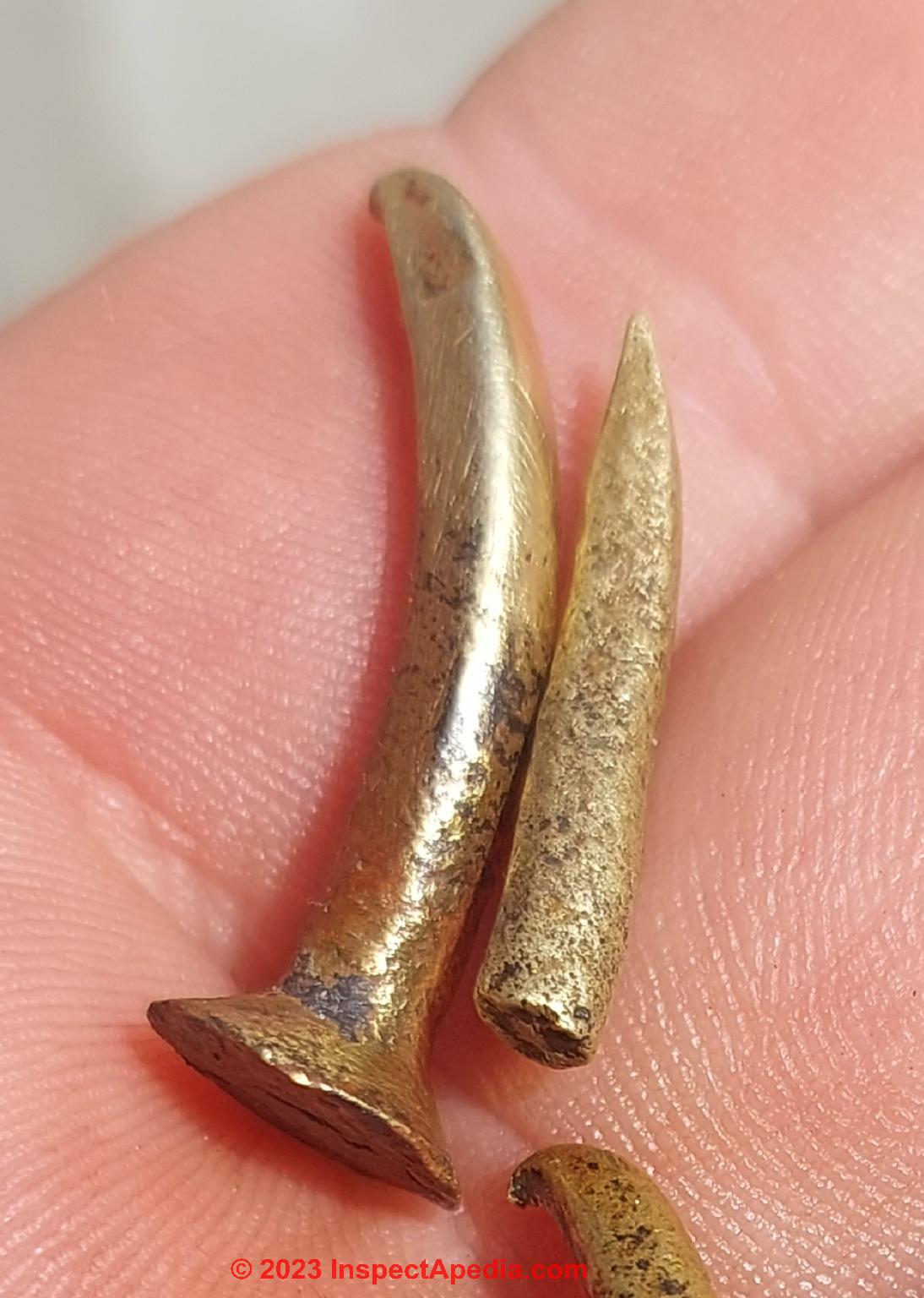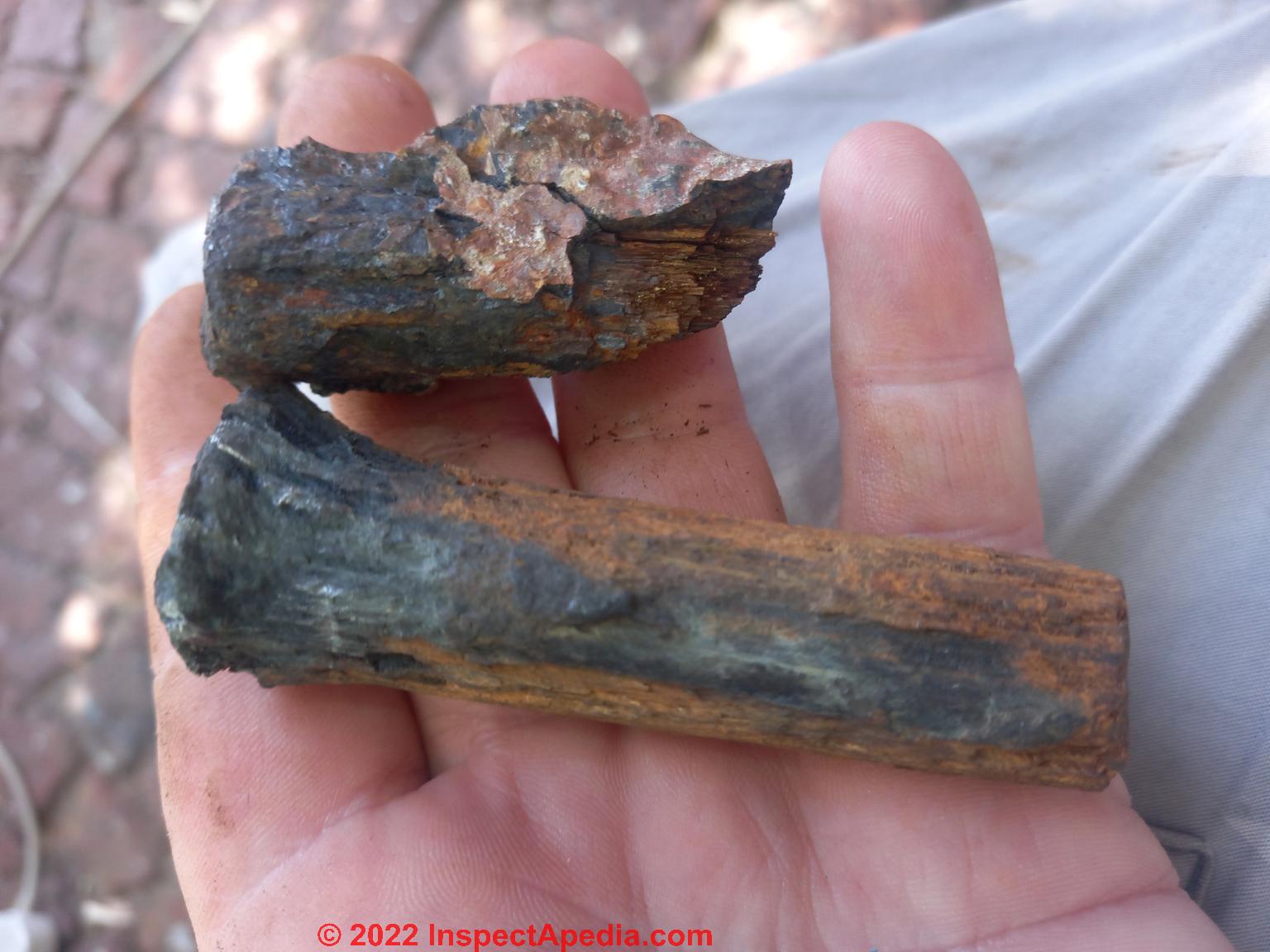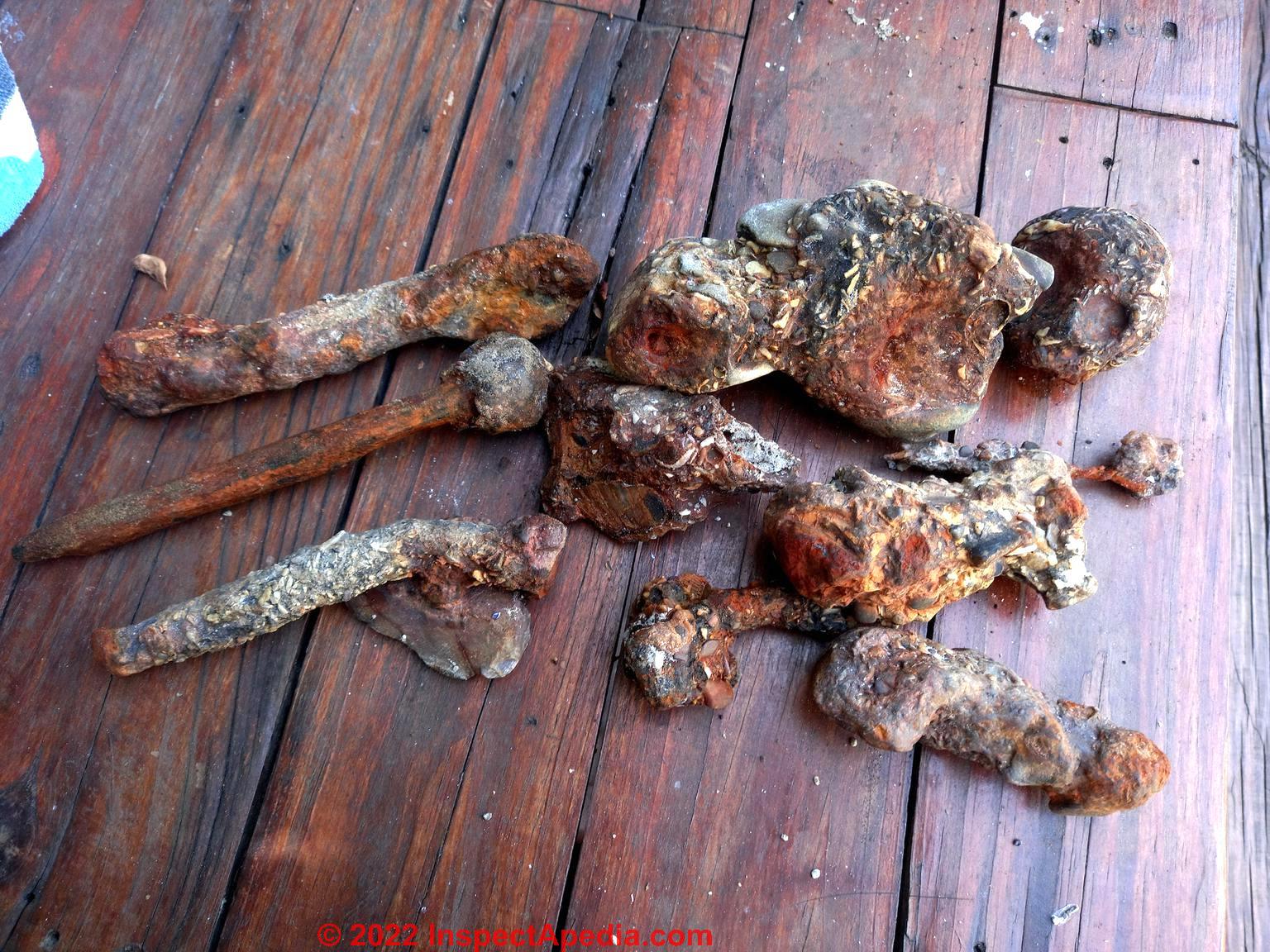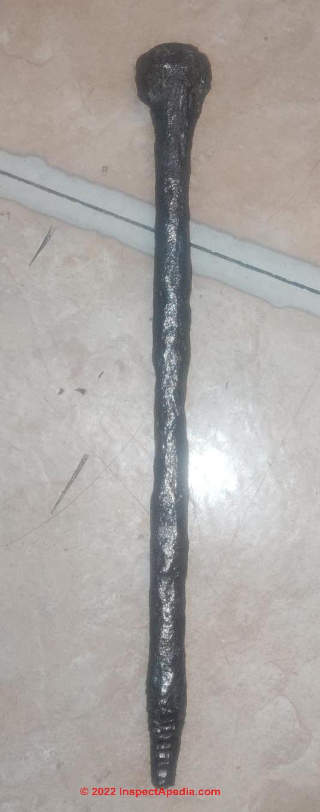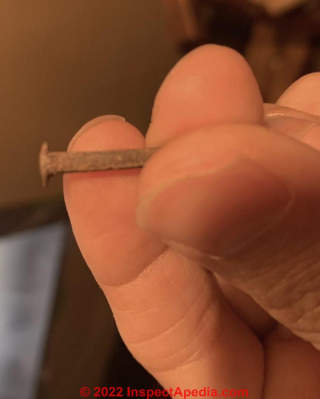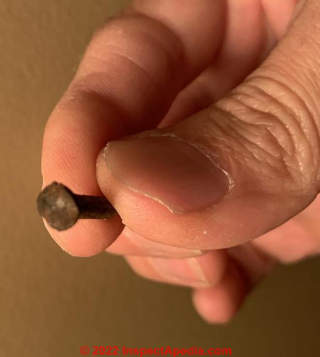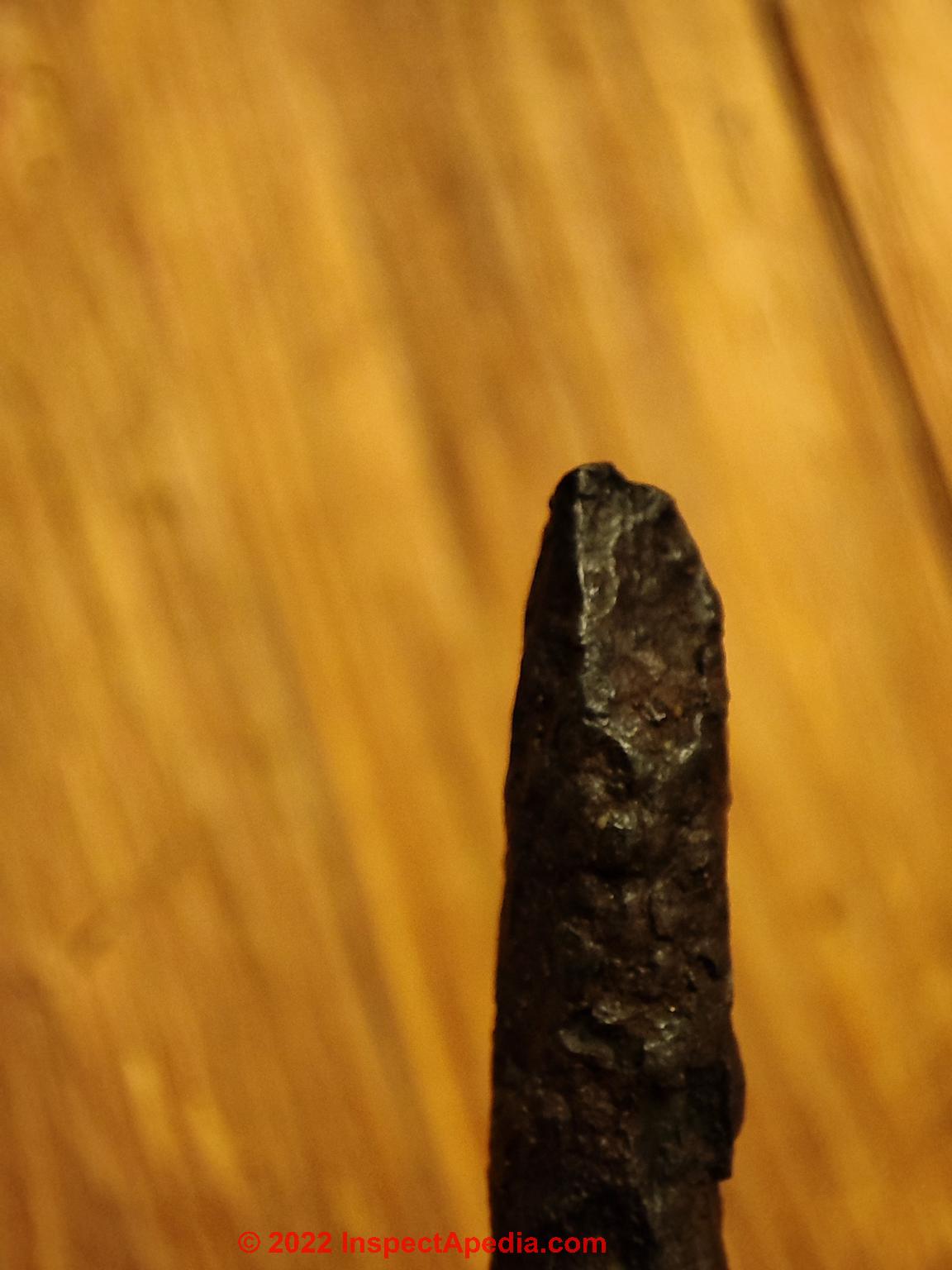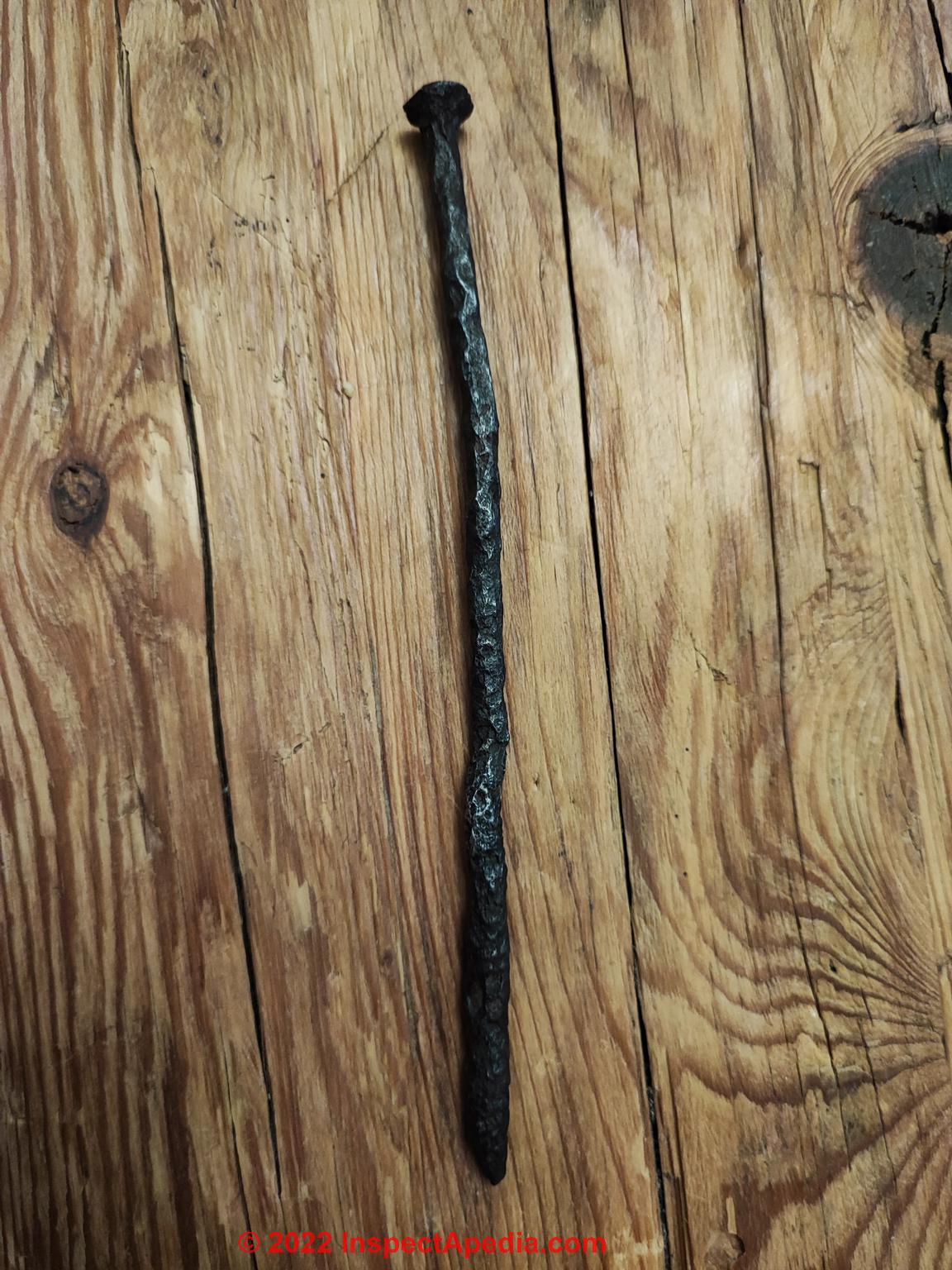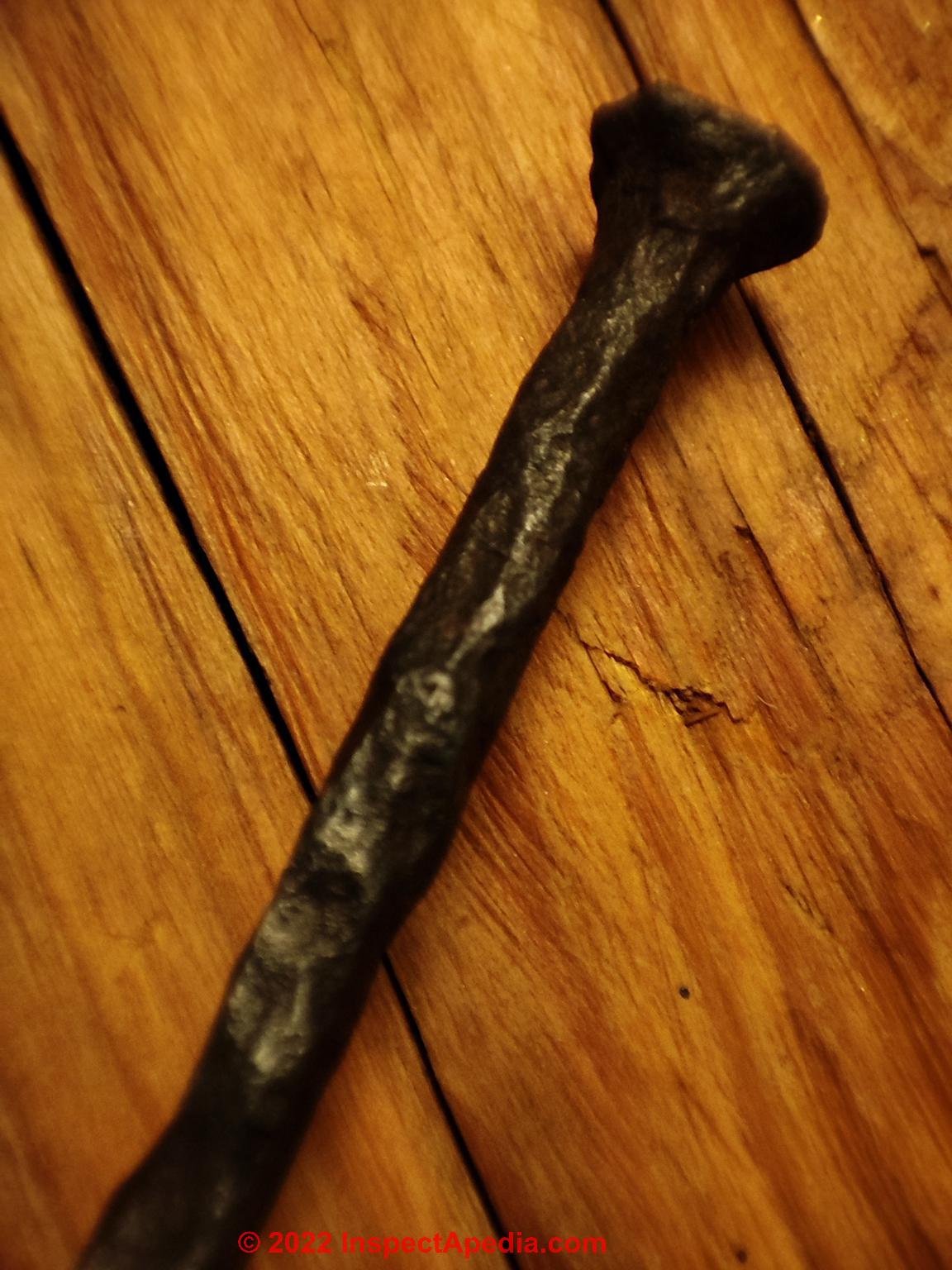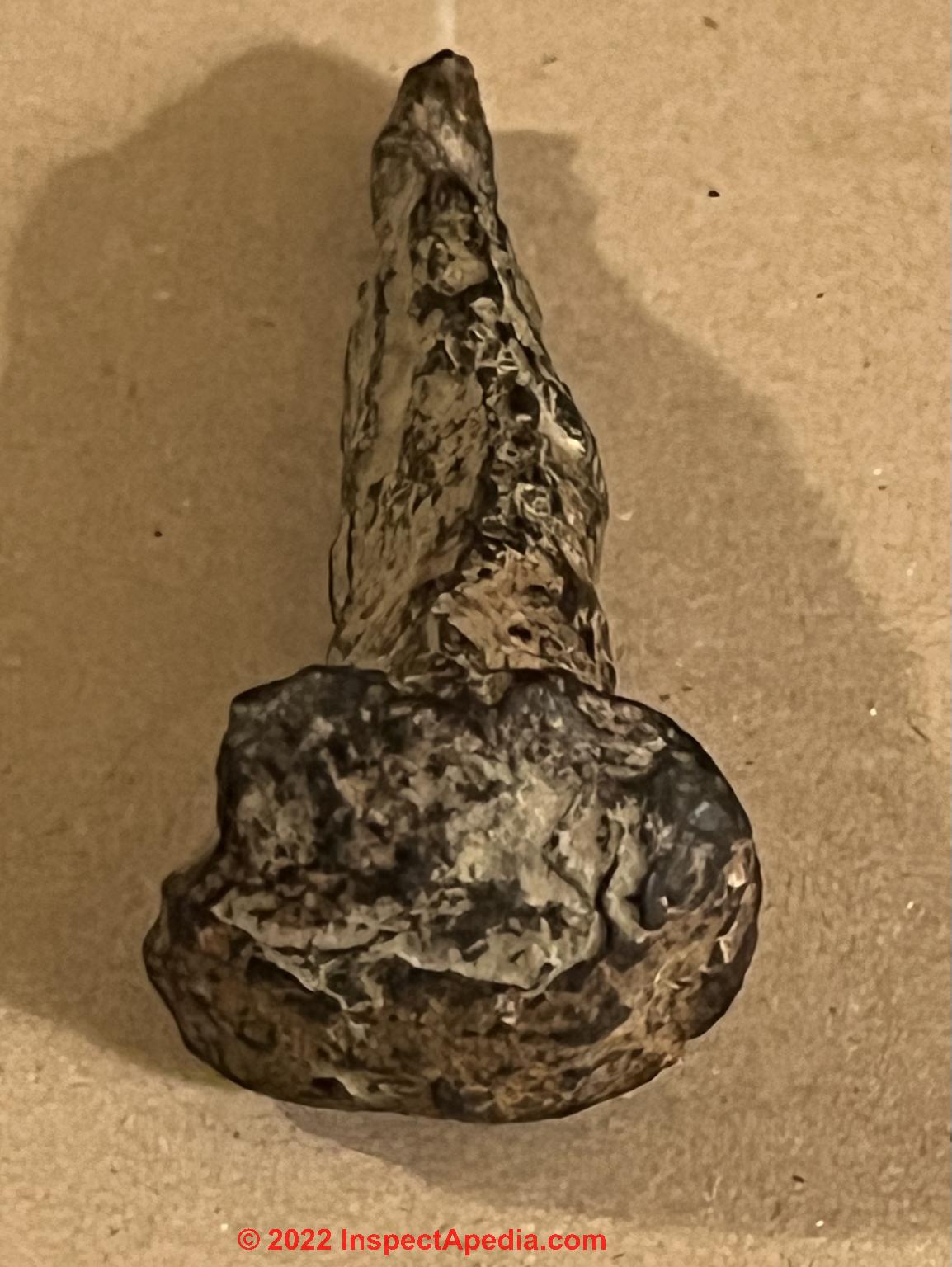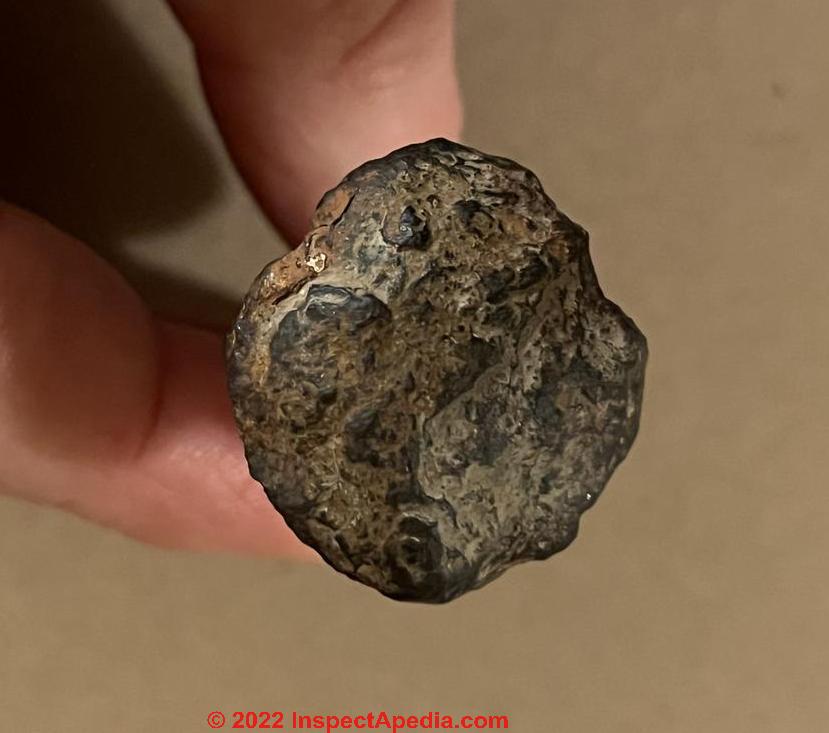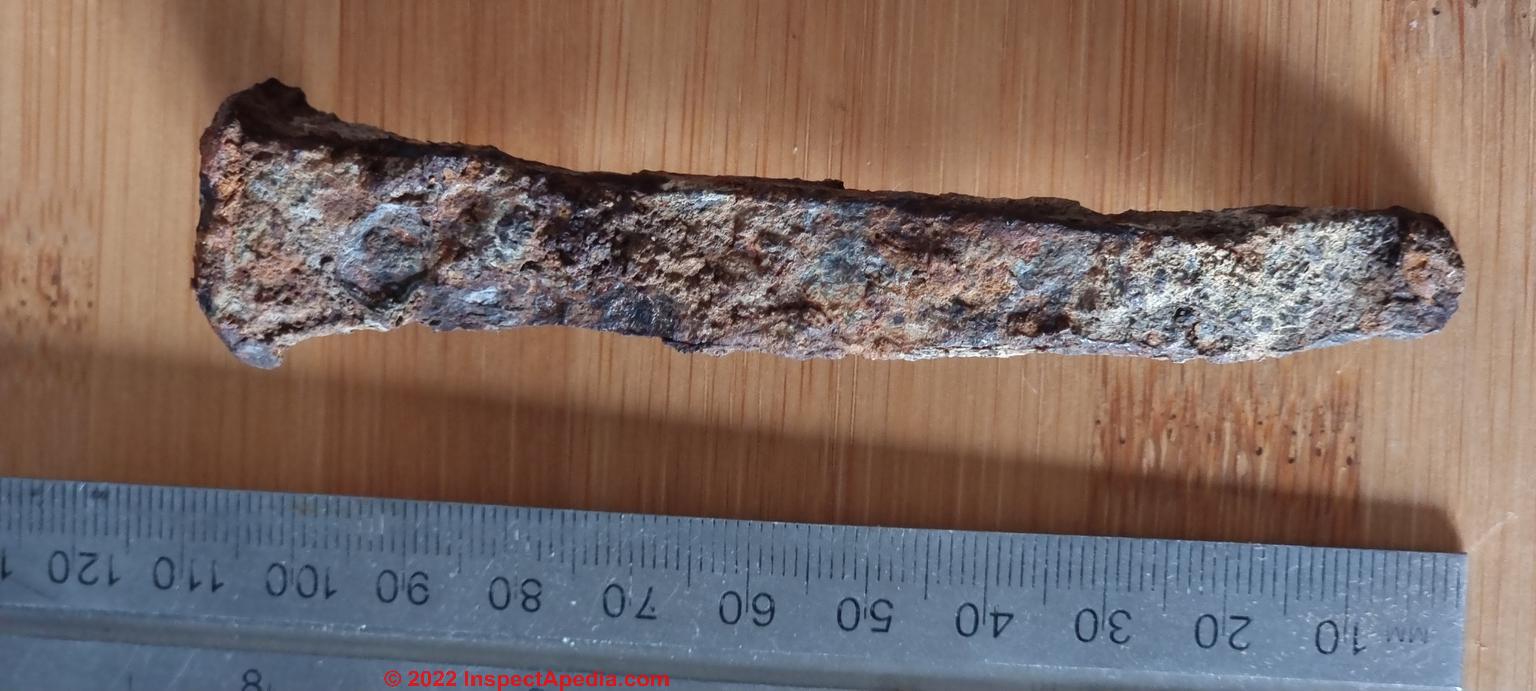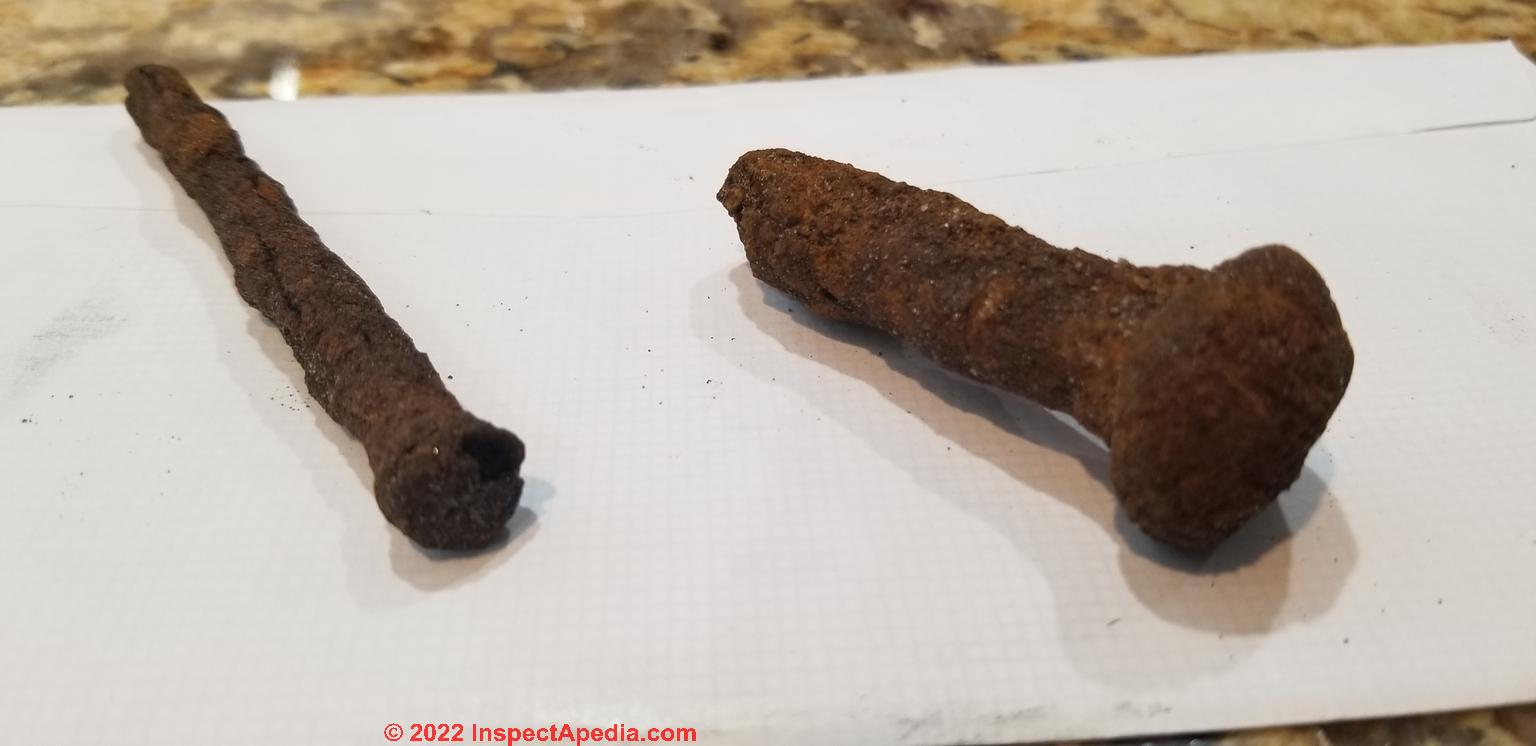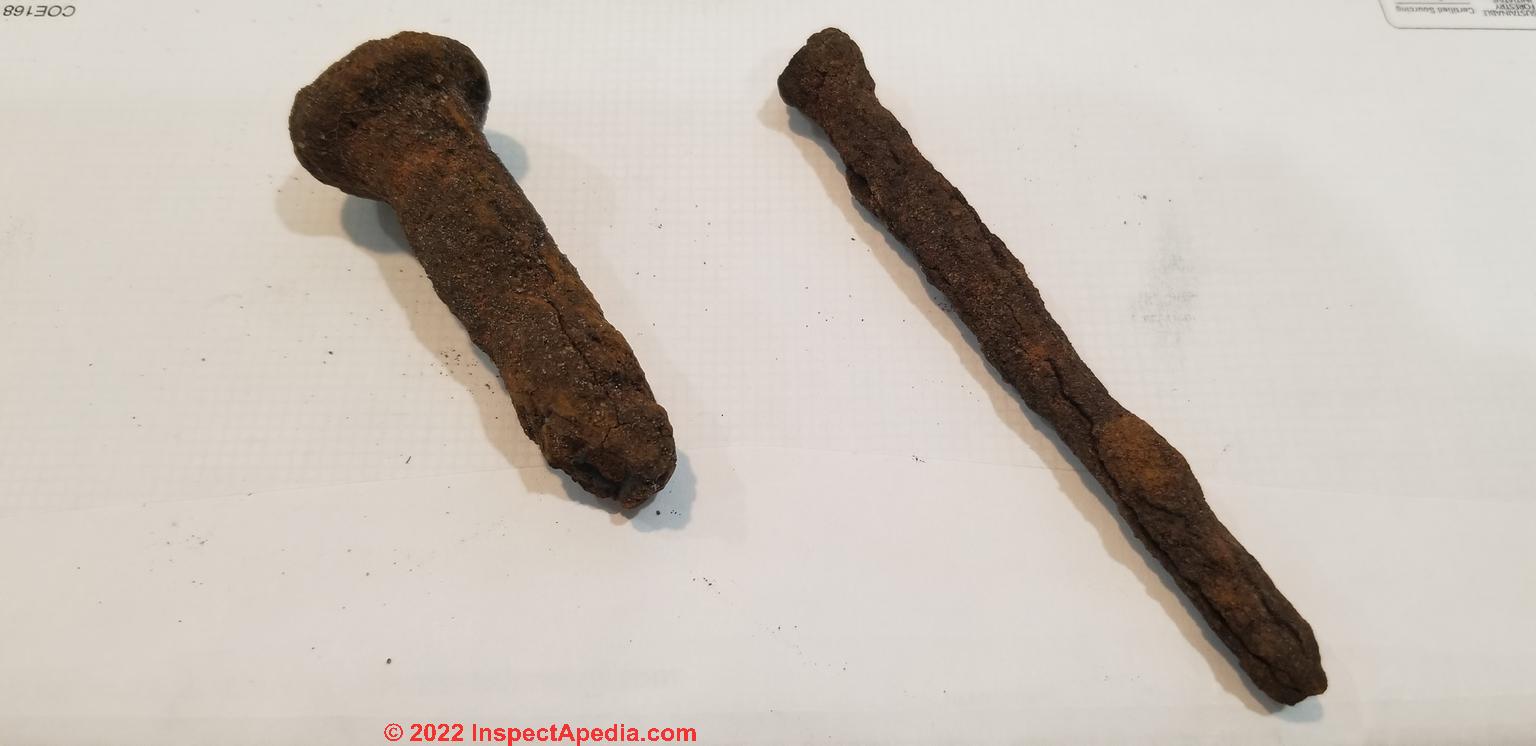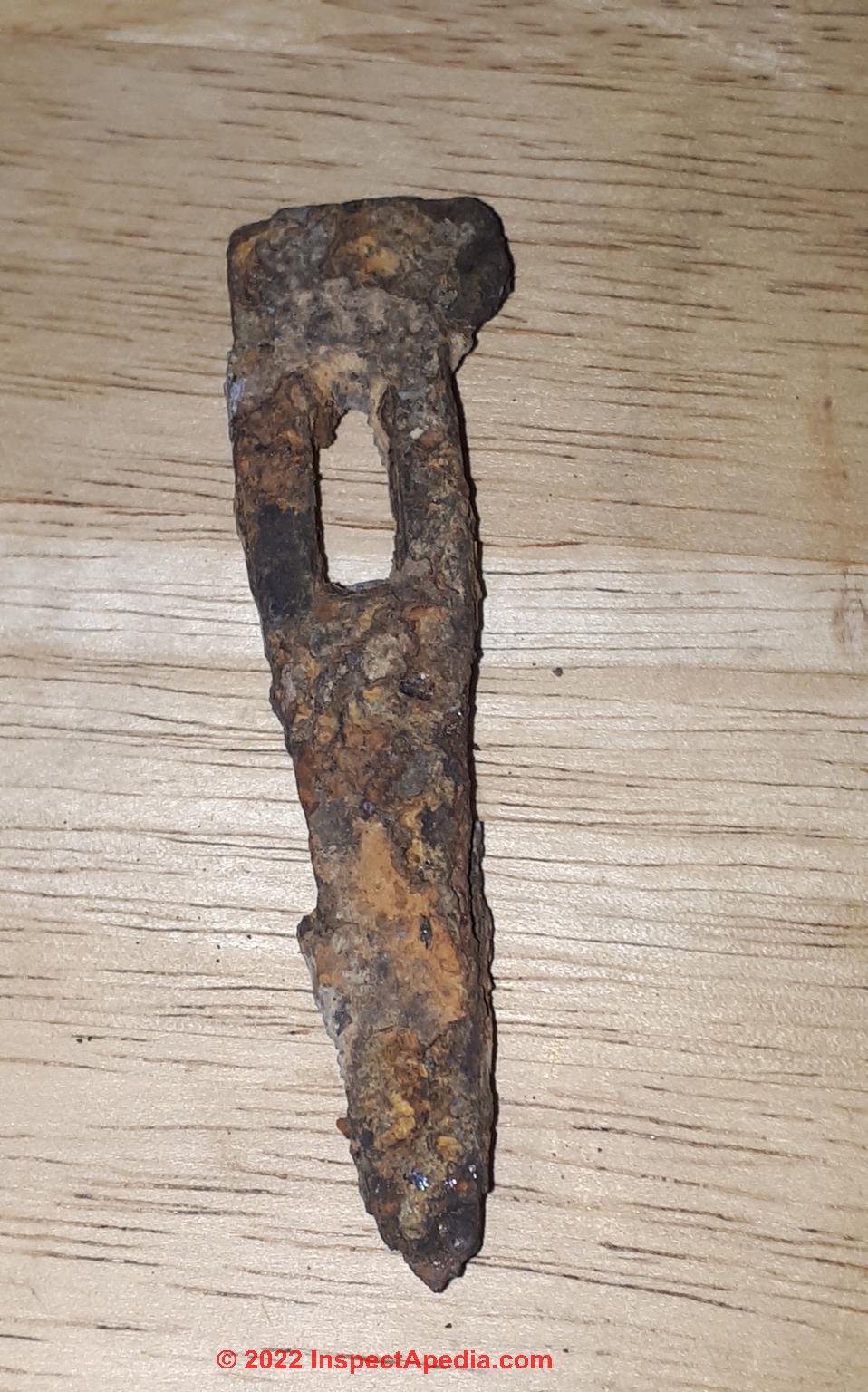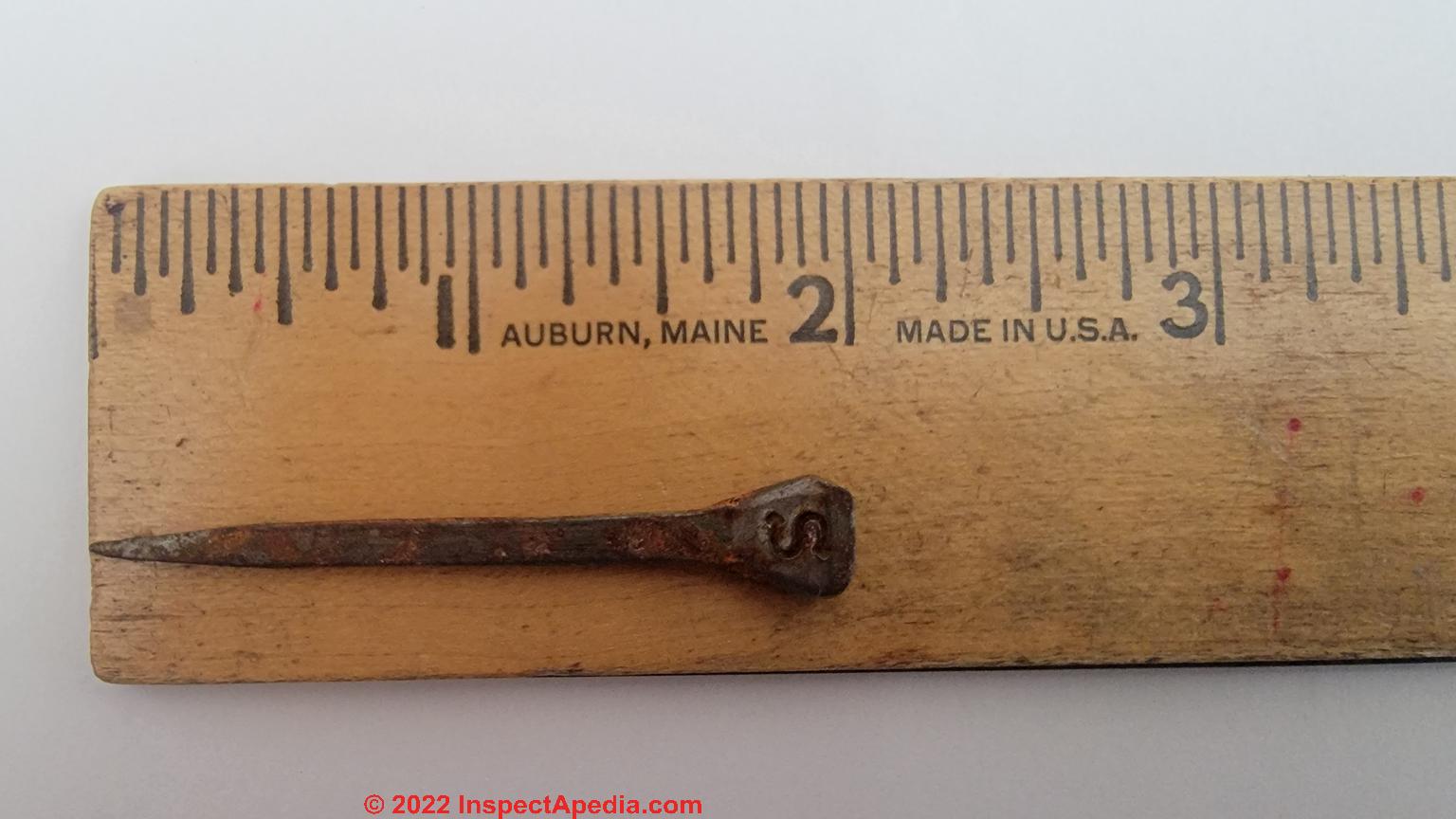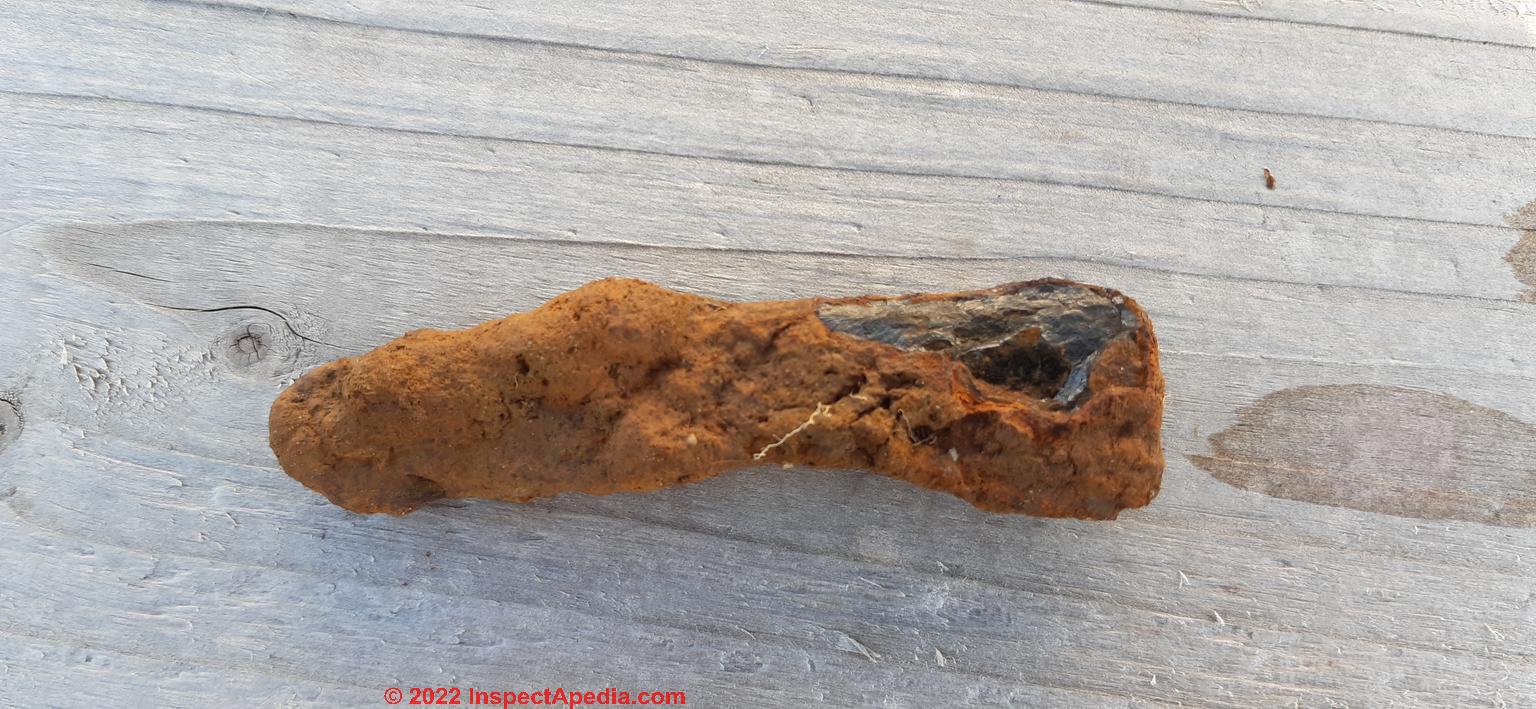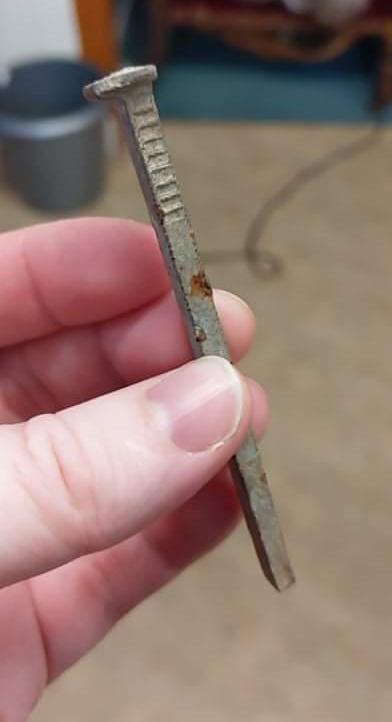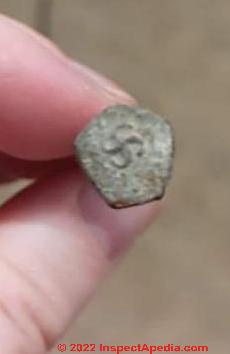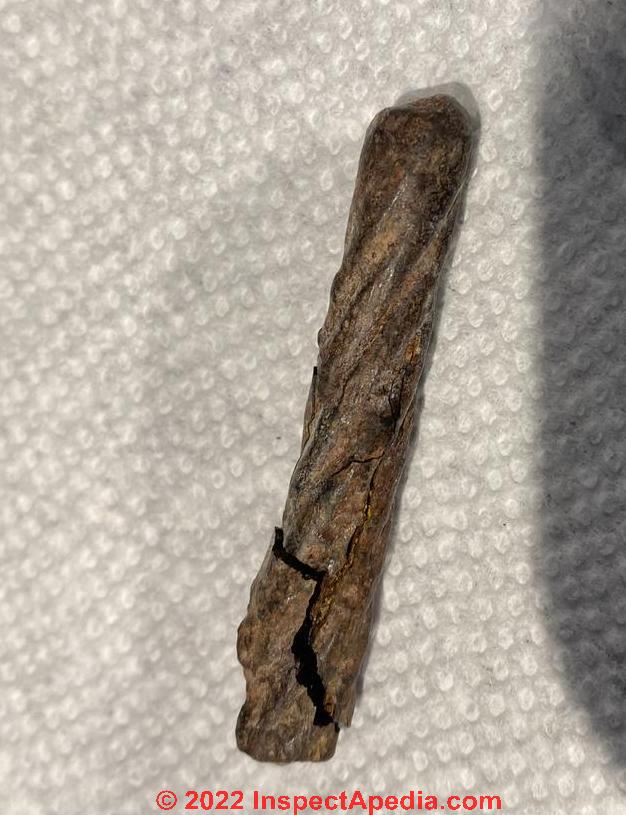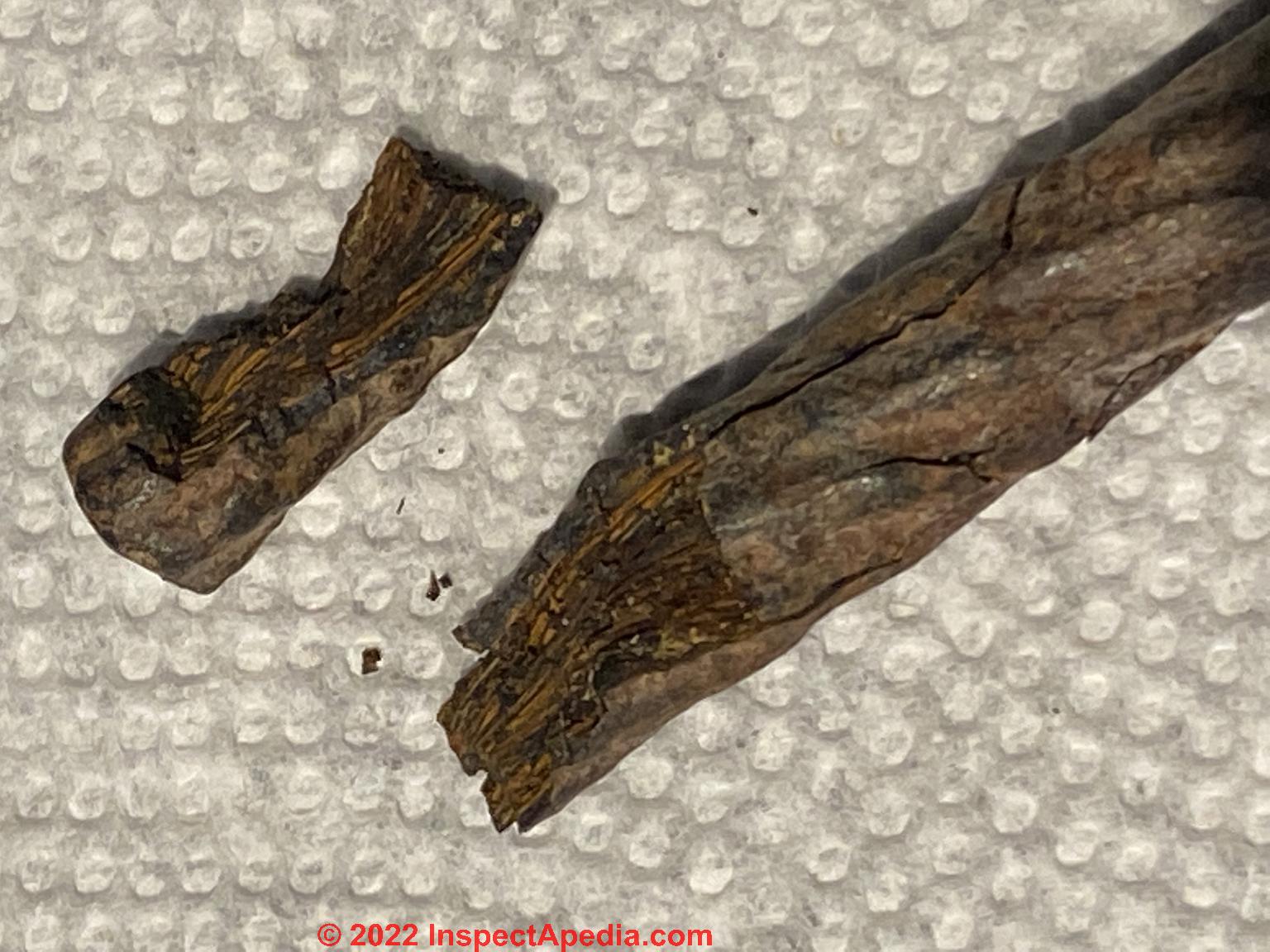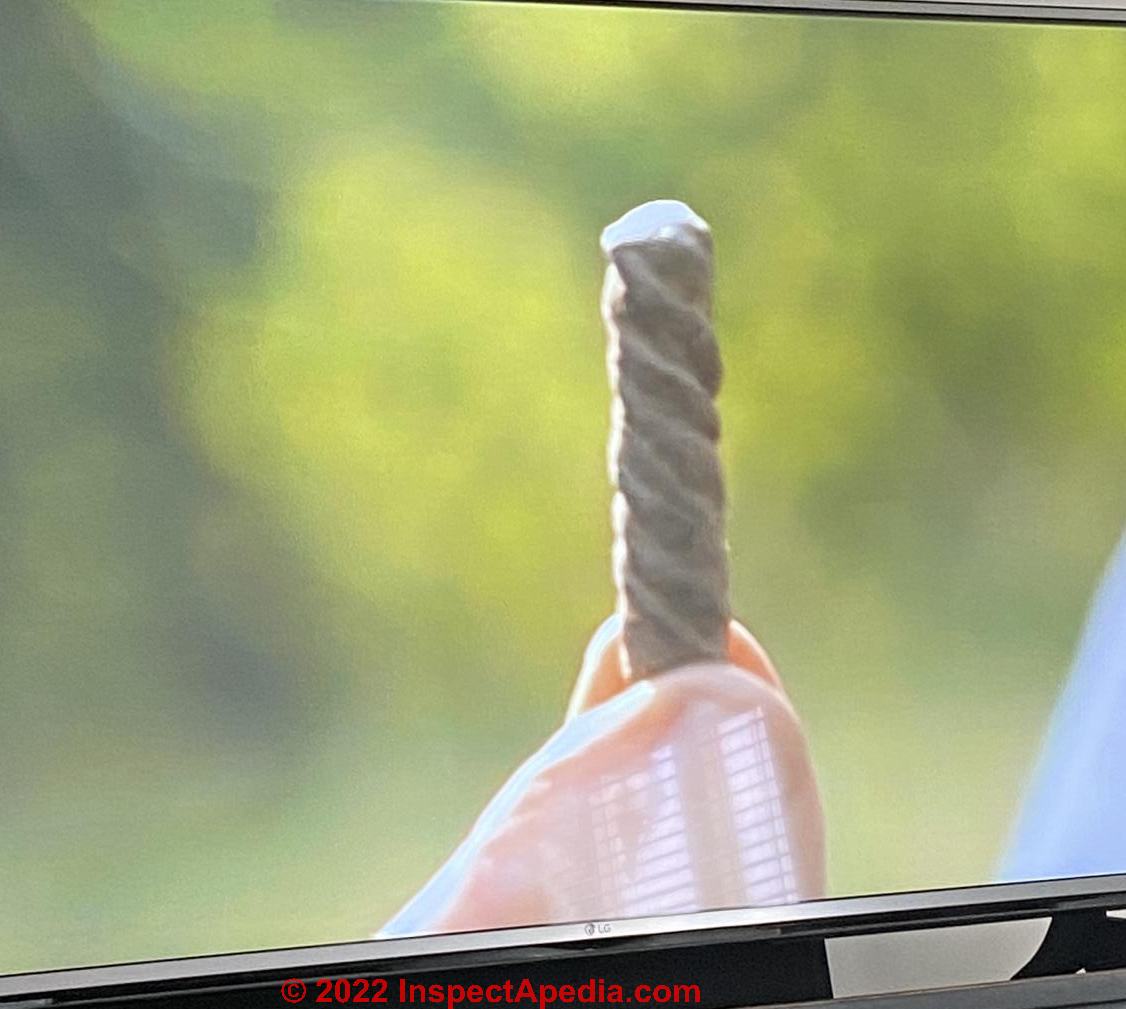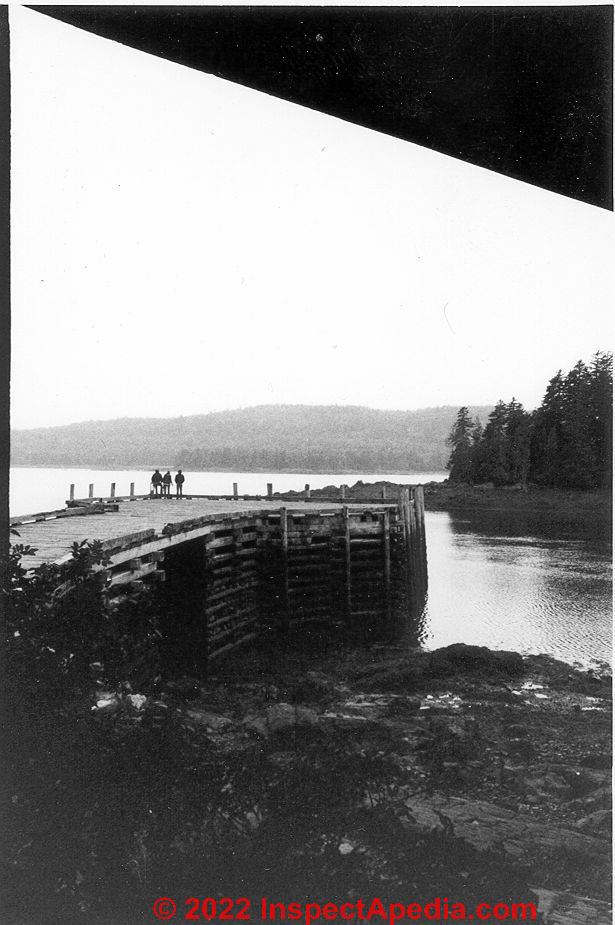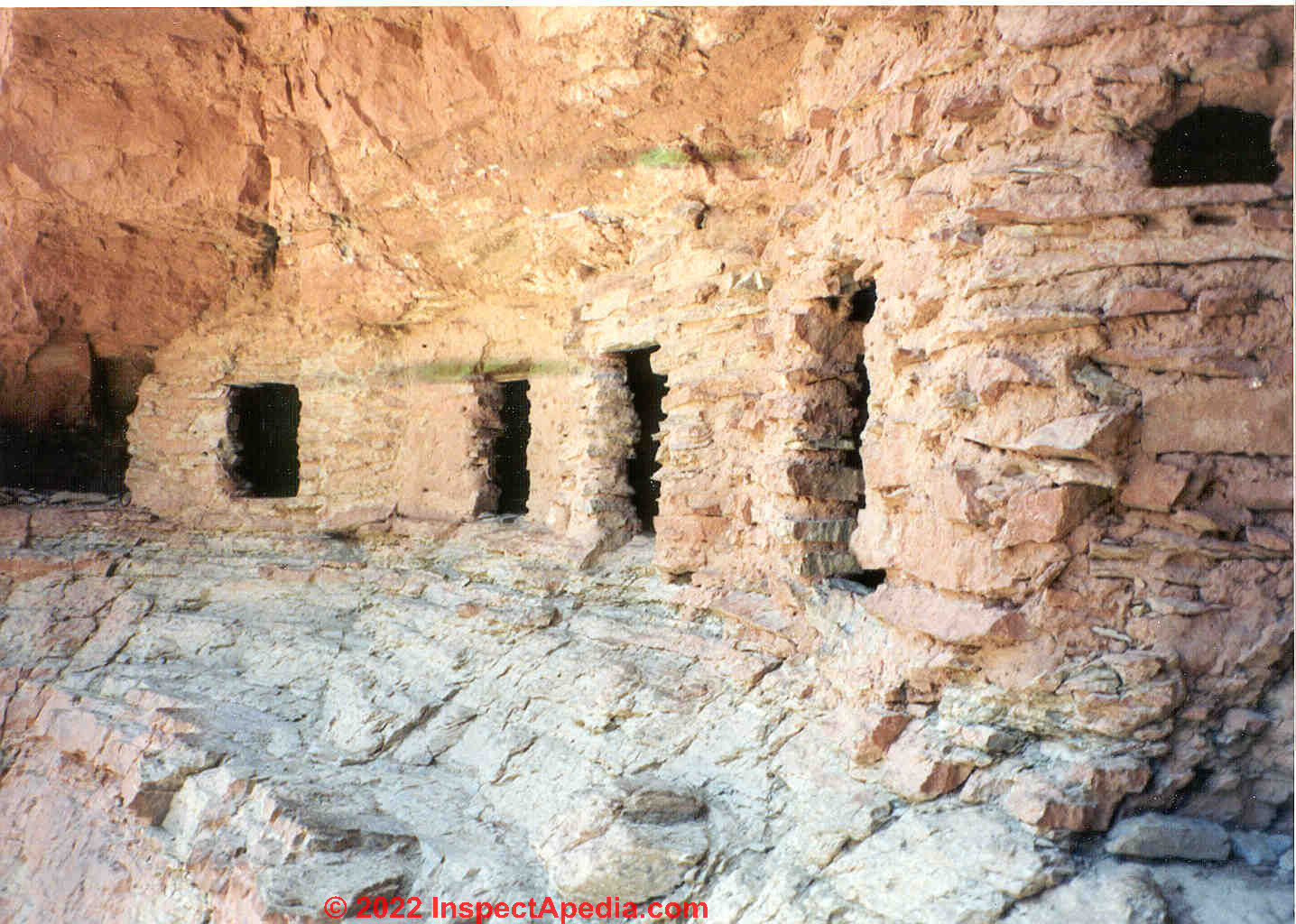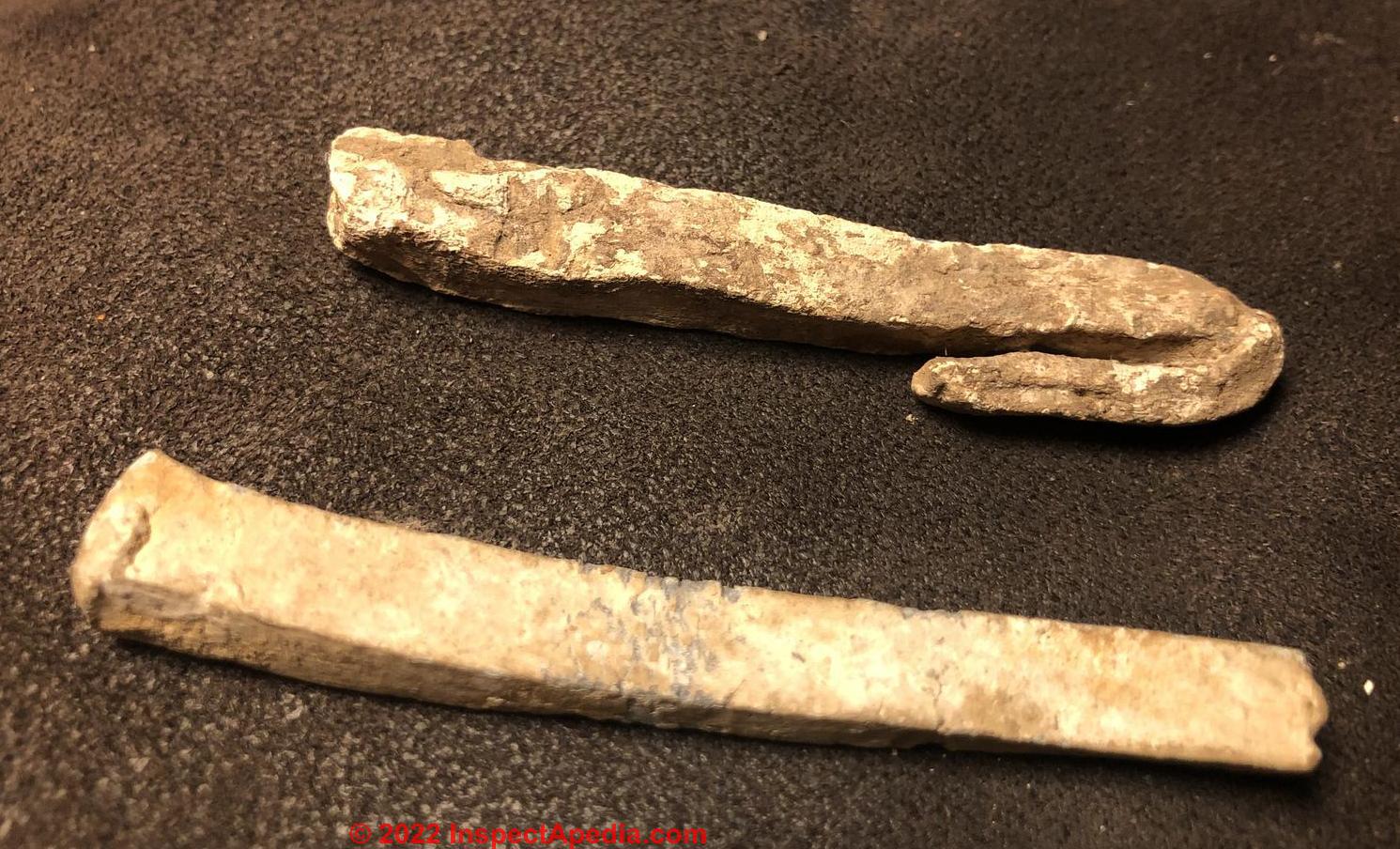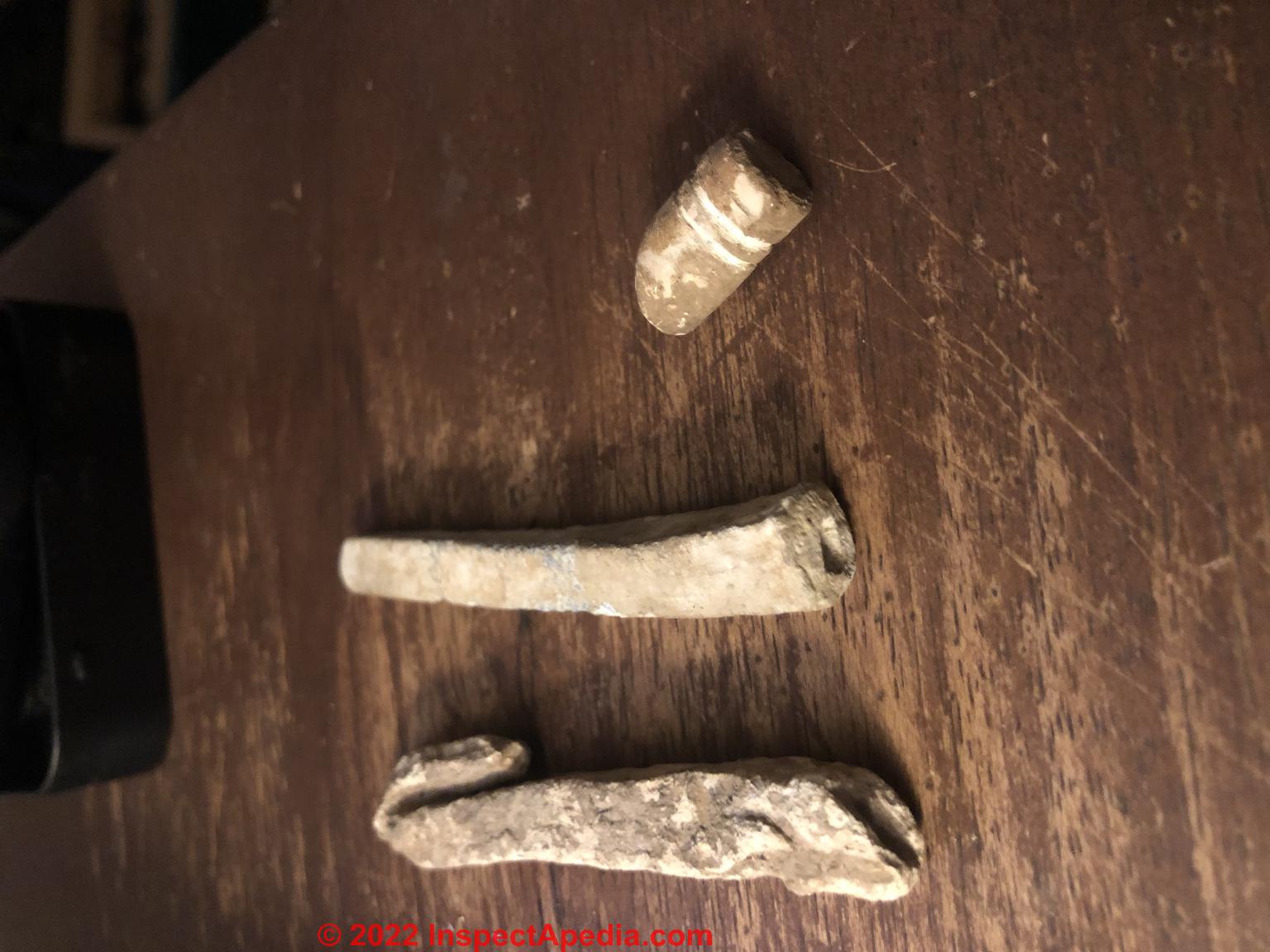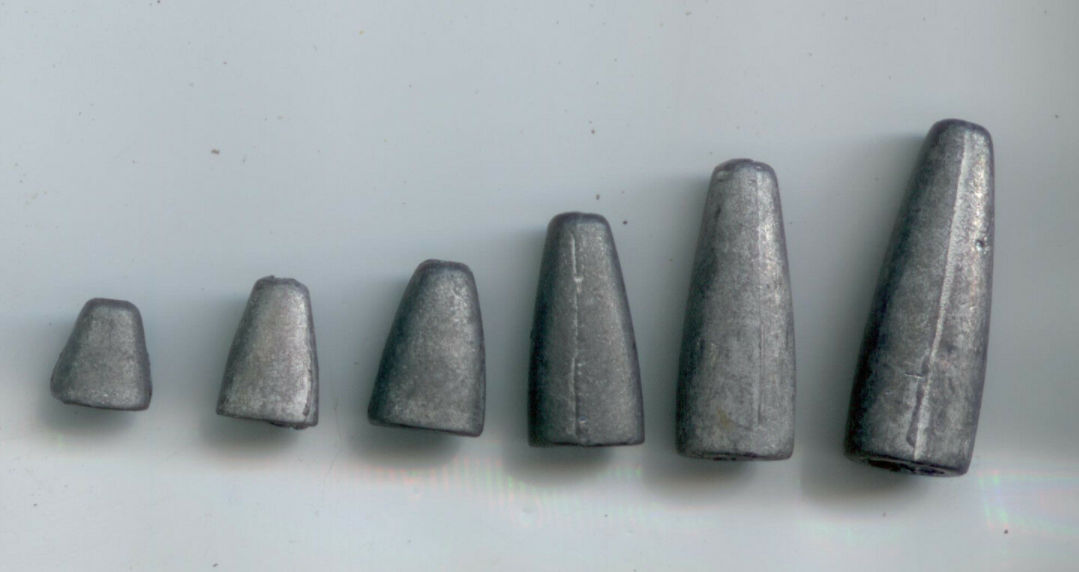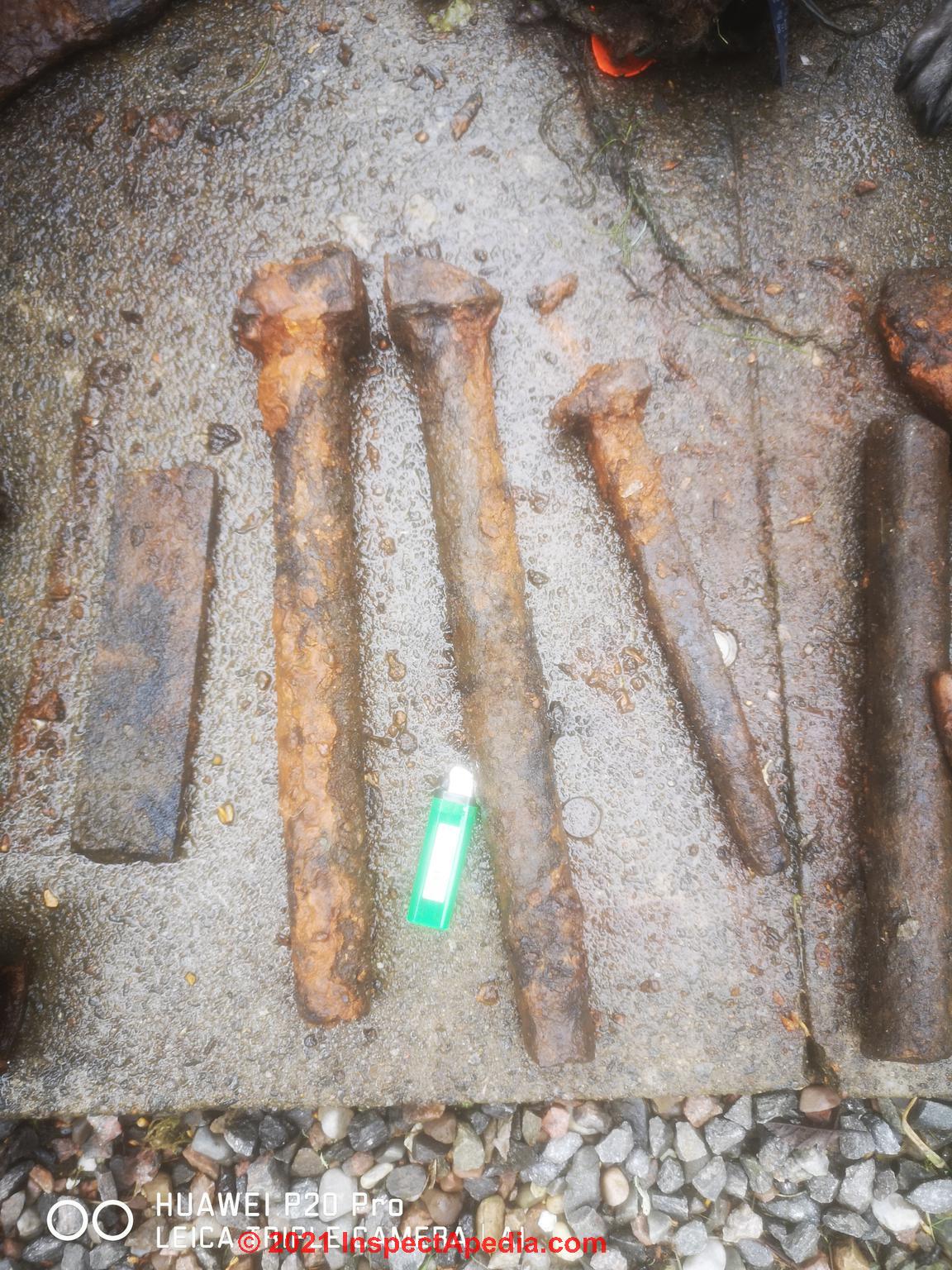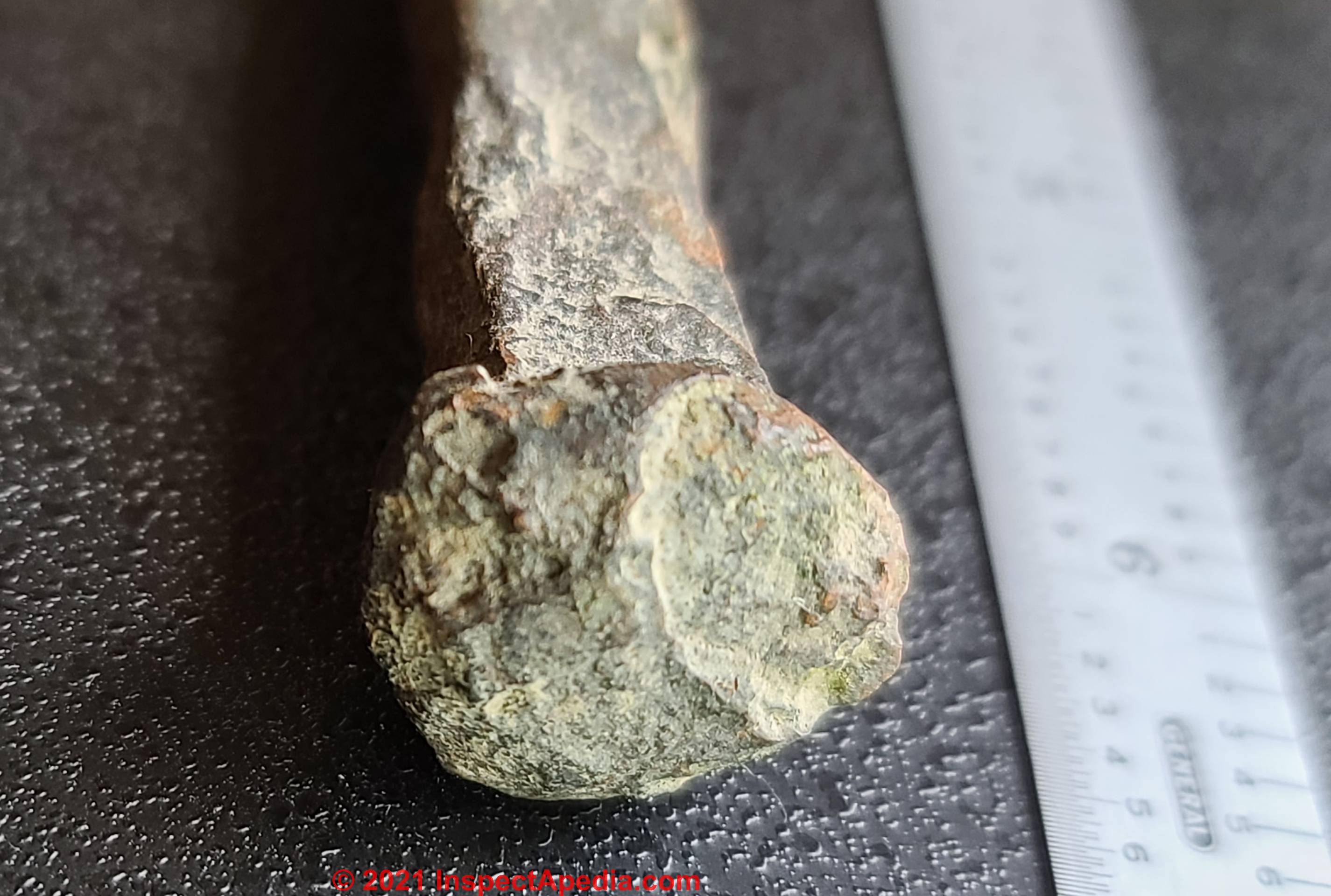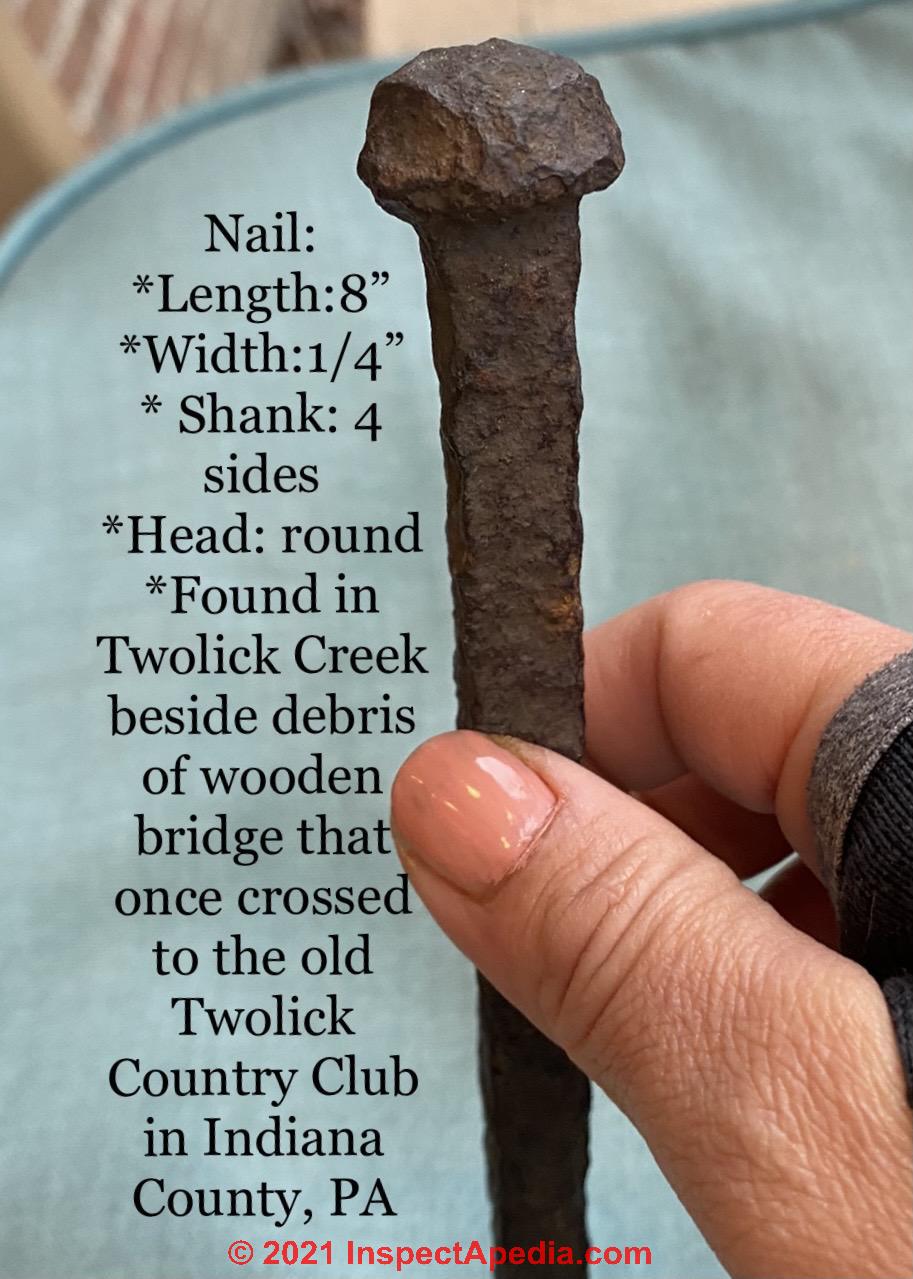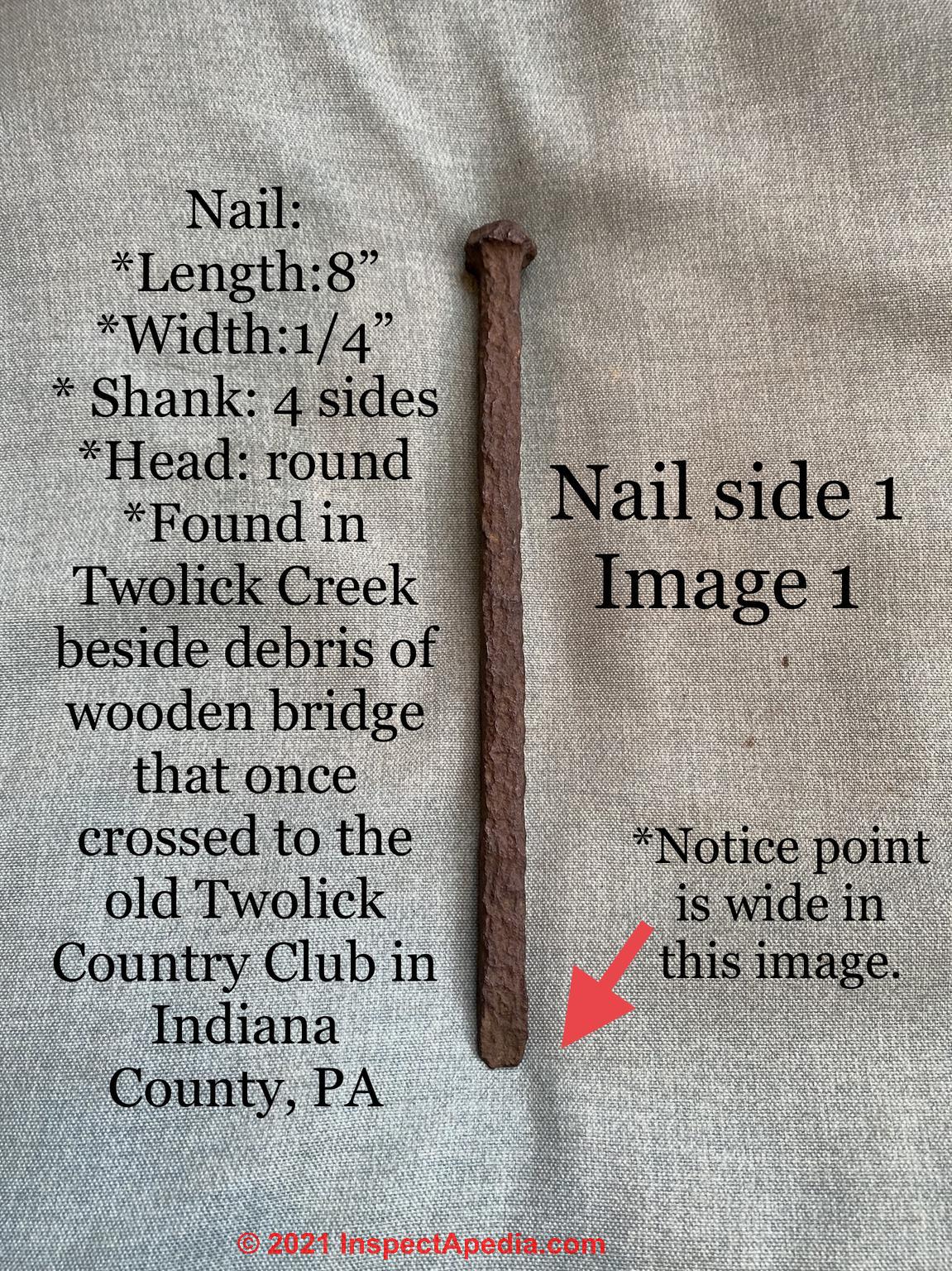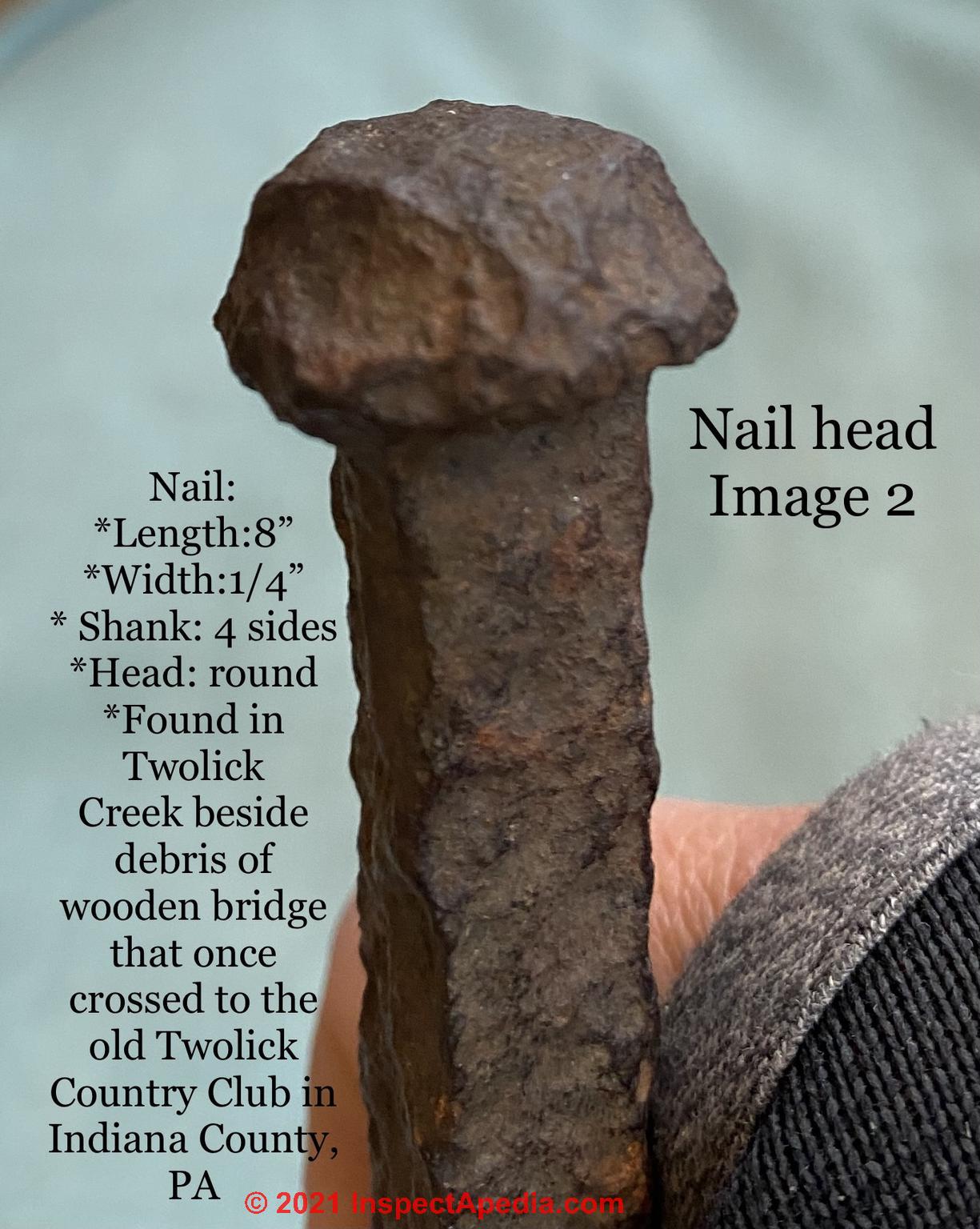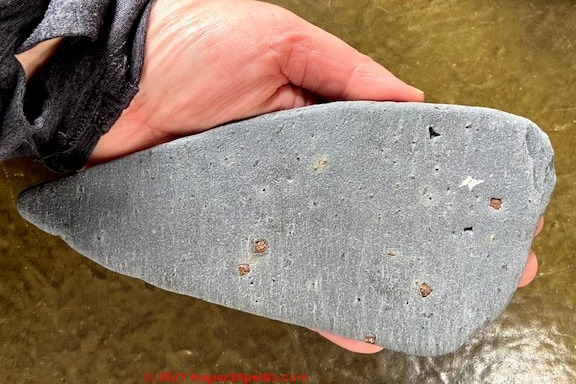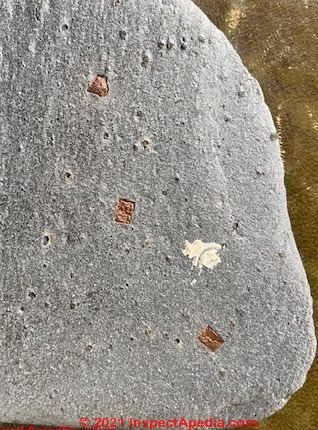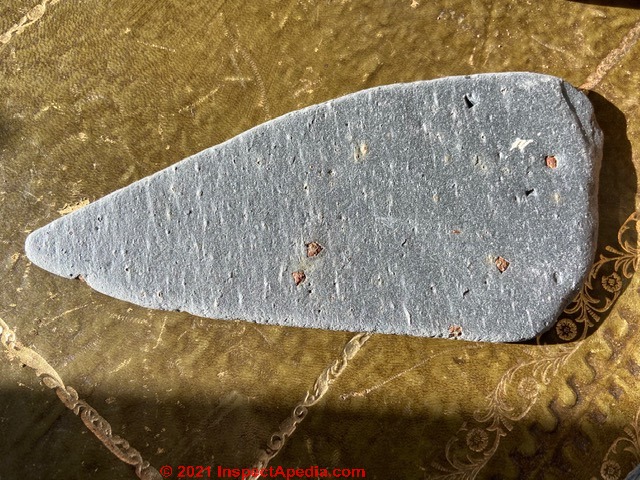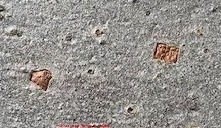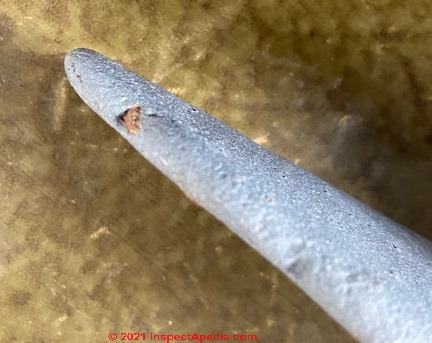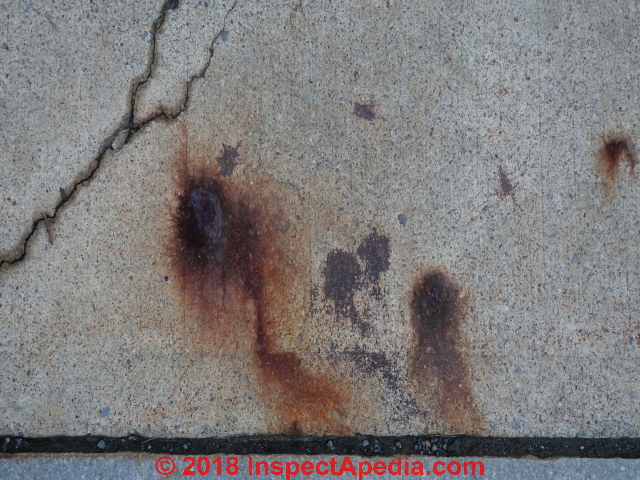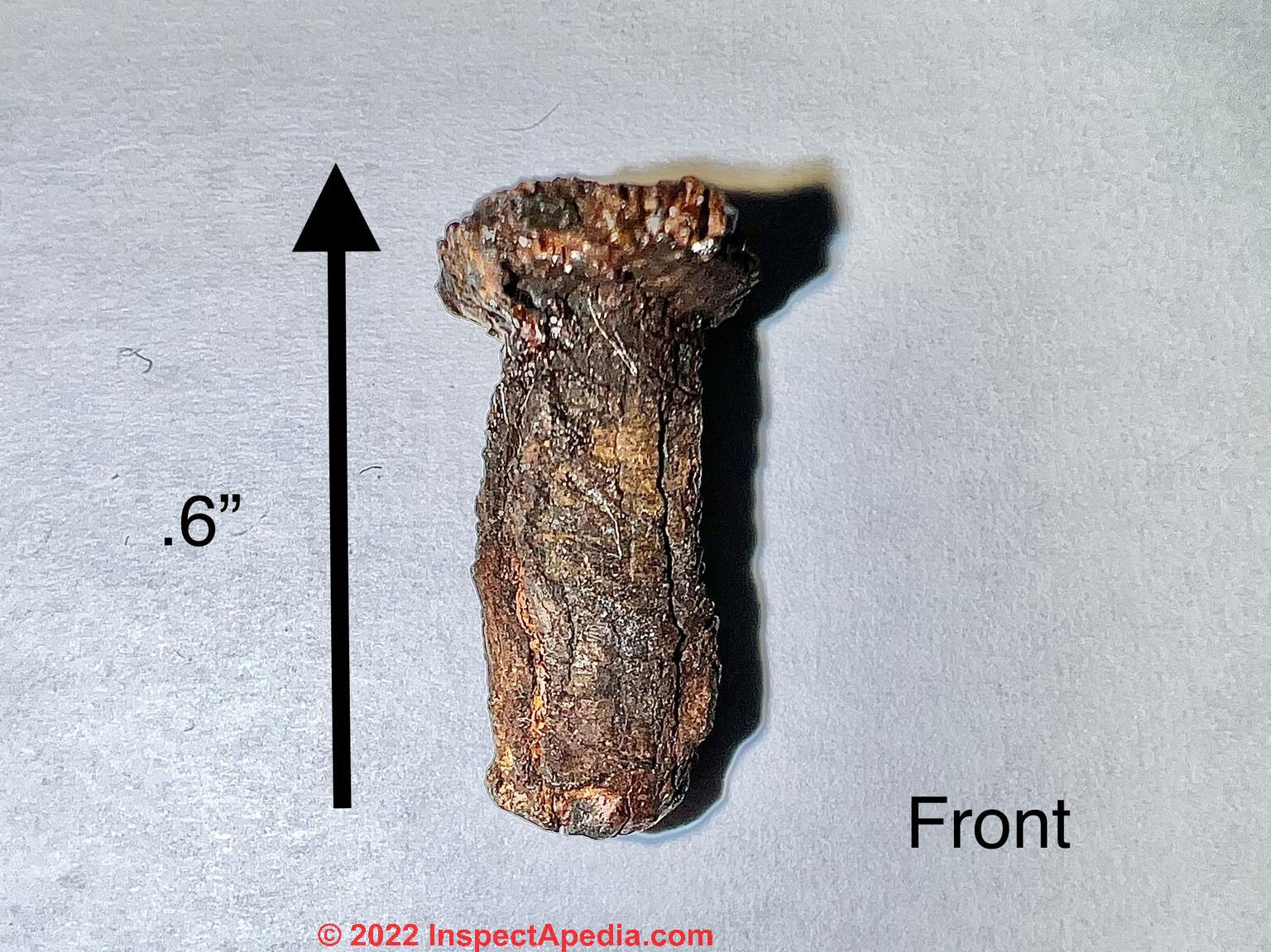 Nail Age & History FAQs-4
Nail Age & History FAQs-4
Nails as Indicators of Building Age
- POST a QUESTION or COMMENT about determining building age by examining its hardware
Antique & Modern Nail age and history questions & answers.
This article series describes antique and modern cut nails focusing on hand wrought and cut nails used in wood frame construction or interior finishing or carpentry work.
Companion articles in this series describes and illustrates antique & modern hardware: door knobs, latches, hinges, window latches, hardware, nails & screws can help determine a building's age by noting how those parts were fabricated: by hand, by machine, by later generations of machine.
InspectAPedia tolerates no conflicts of interest. We have no relationship with advertisers, products, or services discussed at this website.
- Daniel Friedman, Publisher/Editor/Author - See WHO ARE WE?
FAQs on Finding the Age of Nails
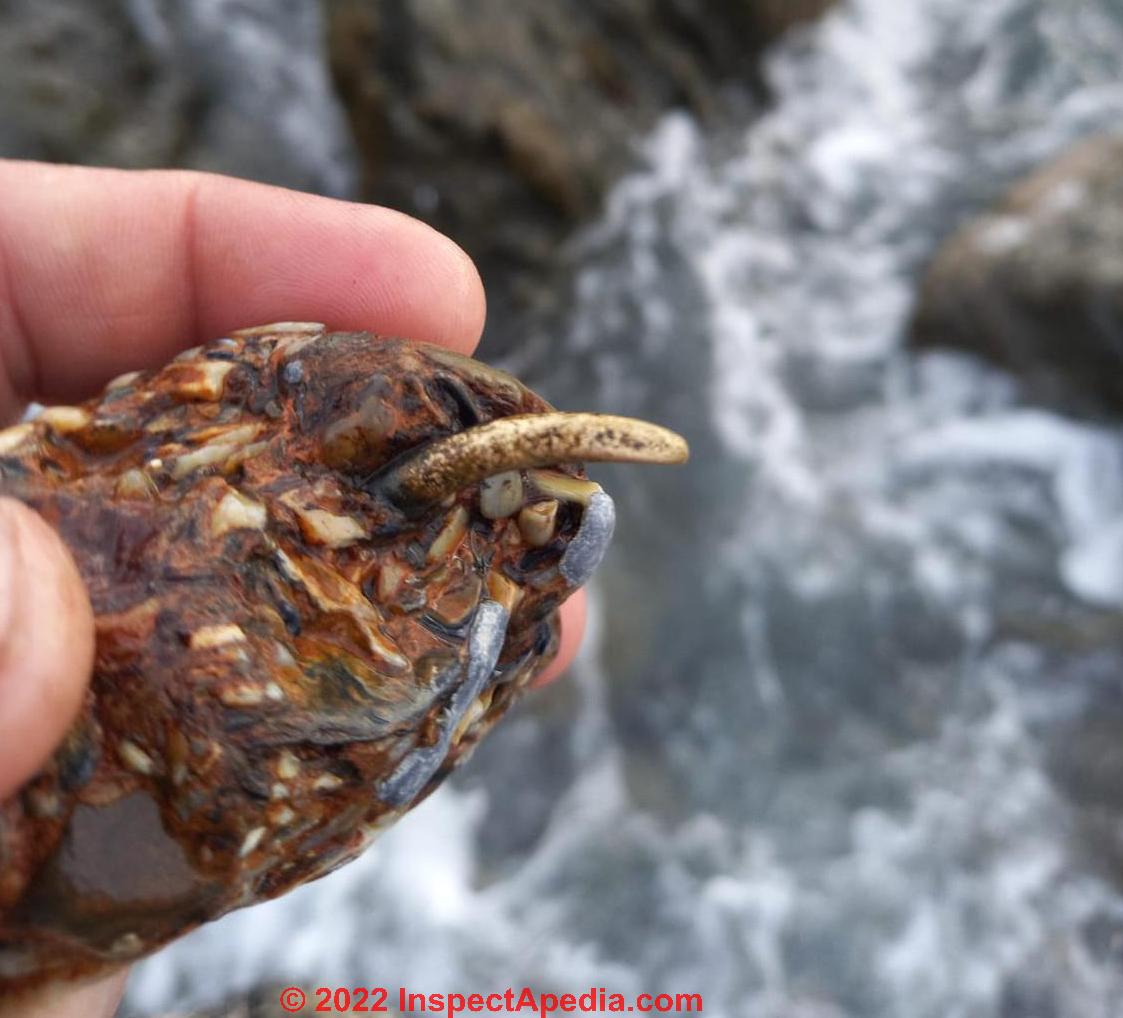 These questions & answers about determining the age of nails and other building hardware were posted originally at the topic home page:
These questions & answers about determining the age of nails and other building hardware were posted originally at the topic home page:
NAILS, AGE & HISTORY - home - be sure to review that article and subsequent FAQs pages.
and
at NAIL AGE DETERMINATION KEY - use this key to guess at the age of your nail or spike
Also see the nail age determination questions and answers suggested there.
[Click to enlarge any image]
How old is the dresser that has these nails in its top?
Nails on the top of an antique dresser. Can you help me with the age of the nails, so I can date the dresser. Thanks. 2022-12-28 by Rob
Reply:
@Rob,
Regrets, but the photo
- shows only the nail head - looking round but irregular - no other details are visible such as the dimensions, and proportions and burr marks or tool marks on the nail shank
- is too blurry so I can't see if those nail head markings are deliberate decorative, results of corrosion, or something else
What are these short bronze tacks?
Hi again
Hoping you could help with these? I can't find anything that matches, found in the same place as the other ship stuff washing ashore.
It scratches gold, doesn't react to vinegar, doesn't go red even with a torch to it,It wasn't discolored like any of the other pieces I've found including nails except the other nails have carbonated. 2023-01-04 by Brent
Reply:
@Brent,
Is that a slot in the head of that brass or bronze fastener ? If so it's probably the upper portion of a brass or bronze screw.The tapered head shape tells us the fastener was intended to be countersunk into wood, as you suggest, most likely from a ship.
Look for and report the surrounding context: Country and city or other geographic point of location, history of that site, etc.
Cape Town South Africa shipwreck debris
Found plenty of these washing up on a beach in cape town, south africa.. different length, even one that had been fashioned into a bone blade dagger type.. hilt made of black iron. Is this from a ship? 2022-12-22 by brent
Find them like this either on the beach in the water
1806 there was a battle off our coastline, Battle of Blouberg, Cape Town, South Africa.. there were 62 ships in the bay but I'm told there are 100s of ship wrecks off our coastline, whatever these are they wash ashore daily,
no one notices because everybody tries to avoid looking at the pollution washing onto our shores..and nobody thinks shipwreck they see it as pollution.. or they don't see it at all
Also from what looks to be a shipwreck off our coast come loose as these all found laying on shore
@InspectApedia (Editor), I found these as well, they scratch gold, they are not plated, tried a blow torch but they don't go red from the heat they are all shaped the same towards the tip, they aren't heavy, and they look like gold... they came attached to some of the pieces I found, they iron everything attached rusted or discolored except these nails.
Reply:
@Brent,
Thank you for that added detail that's very interesting. And of course too bad about the pollution - that's something we're dealing with in a lot of placesMy opinion is just that your interesting photo and question is beyond my expertise but if you found what looks likeapon fashioned out of natural iron ore it could be prehistoric.
Those are interesting too but so thick with accumulated corrosion and debris that it's hard to say much except for the one flat sided spike that's from a modern era probably post 1830.
Iron nail fragment while metal detecting on the beach near a shipwreck site
Found this iron nail fragment while metal detecting on the beach near a shipwreck site. Any ideas as to how old it could be? The nail shaft seems to have broken off and all that’s left is this top portion. 2022-12-08 by Mike
Reply:
@Mike,
One age clue you ca see on that fragment is that crack that runs lengthwise on the nail shaft - that feature is discussed above on this page.
See the section titled
1810 - Present: Modern Machine Made NailsYou will find our most complete advice on guessing age at
NAIL AGE DETERMINATION KEY
https://inspectapedia.com/interiors/Determine-age-of-old-nails.php
Round shanked bolts and nails found near Sebastian inlet
Pic of old unbolt any help greatly appreciated. 2022-12-06 by Jhaas307
Pic of bolt found near Sebastian inlet any help with identity greatly appreciated
Reply:@Jhaas307,
Round shanked bolts and nails are more likely to be a modern fastener.
Two step nail at 1830 Vermont farmhouse
So my tax records date my Vermont farmhouse to 1830. I’m still doing research on the home and looking for clues to confirm that. Found this nail today in the crawl space as I was moving things around. 2022-12-03 by Danny
Question: If I’m trying to confirm the date of a home, what exactly should I be looking for? Style and over structure it aligns.
Reply:@Danny,
I'm not sure but that LOOKS like a two-step nail in which the head was hammered in a 2nd step, possibly by hand - similar in age to your estimated house age.
Look for the nail age details we give above on this page like
- tool marks
- burrs on various edges
- any cracks indicating direction of iron fibres
Identifying antique Philadelphia clout nails
I am transcribing handwritten letters from 1861. The architect/builder author speaks of nails used for tin roofing.
The word ends in "out" but I cannot distinguish the first letter or possibly two letters. They cost $1.25 for a dozen papers of a pound each, and were sold by a company in Philadelphia.
Could you tell me the correct name for these nails used to apply tin roofing? 2022-12-01 by KH
Reply:@KH,
See the Antique Nail Guide Key #2 diagram at
NAIL ID - AGE
that mentions a clout nail. Perhaps this is what you're trying to identify.Follow up:
@Mak Church, Perfect! That must be it. The letters were written by Thomas Ustick Walter, who designed and built the Capitol dome. I'm working on letters from 1861, the run-up to the Civil War.
He was a deeply decent man who was trying to manage his 11 children, his home, the US Senate and Congress and a jealous competitor, among other upheavals. He also designed Girard College in Philadelphia, an stunning masterpiece - as if the Capitol dome weren't enough.
I come from a family of builders, and the letters are fascinating - his concerns were not unlike those of builders today. Many thanks for the information! His handwriting is very clear, but some bits have been blurred over the years.
Where are you located? Should you visit Philadelphia, be sure to go to Carpenters Hall and follow their walking tour.
Reply:
@KH,
Sounds like an interesting project. Glad to have been of help.
Antique Polish nail tip and nail shank details
Hi, I found this nail in Poland, Europe. From what I've learnt from your page it's hand forged, am I right? Does it have any features that would help determine its age? 2022-08-27 by Mike
...
...
...
Reply:
@Mike,
Yes that's certainly a hand-forged nail - as it sure appears to have hammer marks, an irregular head, and there are no machine-grip marks on the shank below the head.
The nail tip also is just a two-sided wedge common of handmade nails.
Sometimes a nail or spike has splits that show the direction of iron fibres that can help guess its age, as you'll read at
NAIL AGE DETERMINATION KEY - use this key to guess at the age of your nail or spike
https://inspectapedia.com/interiors/Determine-age-of-old-nails.php
When there is no other obvious observation to add from the nail or spike itself, it's still useful to consider the surrounding context in which the item was found: information such as history of a site or a building or name and (if known) age of site or building where an object that is the subject of a question has been found or even the nature of activities at that site over its known-history.Follow up:
@InspectApedia (Editor), Thank you! The metal fibers seem to go along/parallel to the length of the nail
Reply: hand forged nail made after late 1830s
@Mike,
The fact the iron fibers in your nail run lengthwise (parallel to the nail shank) suggest that the nail was probably made after the late 1830s.
Railroad spike collection
Hi, can you help me id/date these railroad spikes? They were found beside the original 1854 track going through Cary, NC (Wake County), but still used today as well. I found 3 so I will do 3 separate postings. 2022-12-31
by Katherine

Reply:@Katherine,
Nice railroad spike collection
I'm looking for good railroad spike head identification markings and codes sources and will add those referencesat RAILROAD SPIKES
where we have moved all your photos and our full discussion.
Hand-forged spike or nail
Can you give me any idea how old this nail might be? Found near Dartmouth, UK. 2022-12-25 by Jenny
...
Reply:@Jenny,
I suspect that's a hand-forged spike or nail, though it's so corroded that we can't be sure if we're seeing tool marks or variations in loss of iron off of the surfaces.
The irregular shank is an argument for hand-forging before cut-nail machines were in use.
Horseshoe with horseshoe nails
My neighbor recently dug up an old horseshoe in his yard located in the suburbs of Indianapolis, and I am attempting to determine the approximate age of the piece. I have received significantly varying age ranges from a professional farrier and the Indiana State Museum.
The museum said I can narrow down the date based on the type of nails used. After some rudimentary searching on the history of nails, I find myself utterly lost. Five pictures to follow. 2022-11-05 by Neal Harvey
Reply:@Neal Harvey,
Thank you for the horseshoe and horseshoe nail photos and question.
Please find your question and photo along with a lot more about the history of horseshoes and horseshoe nails now at
HORSESHOE & HORSESHOE NAIL AGEFollow up:
@InspectApedia (Editor),
So it appears that the shoe is post 1835. Is there an approximate end date for use of this type of nail?
- NealReply:
@Neal Harvey,
The references and details at the article I suggested give some end uses for horseshoe features but nails are a bit less certain, at least so far.
Please do take a look at our discussion now moved to that page.
We welcome your further comments, suggestions, questions, critique.
Rusty nail dug up in garden
I dug this up in my garden, this area has been farmed and mined for lead since Roman Times, any ideas as to what it was used for? thanks. 2022-09-24 by Denise A
Reply:
@Denise A,
Large iron spikes like that were often used in timber frame construction.
Northamptonshire rusty nail near many historic sites
Hi, for context I found this nail in the garden of my home in Northamptonshire. The house dates at 2008, but within 300m there are sites of: Roman villa; iron age forge; Anglo-Saxon moat and burials; Norman manor; several listed buildings running up to the present. 2022-08-24 by Flappy Raven
Using the guidance on this site, the best I can guess about this nail is that it is hand forged because it tapers in a single plane, appears to have a hand-formed head, and seems to have directional graining (although that could be exfoliation corrosion?)
I'm fascinated, can anyone enlighten me please?
Reply:
@Flappy Raven,
In essence, as you’ll read above, when estimating the age, properties, use, and history of a metal fastener like a nail, spike, or screw, we look at
1. the item itself for clues about how it was made, of what materials, and in some cases iron fibre direction that can bracket age of manufacture
2. contextual clues: what we know from surrounding materials, location, history of the area, etc.
It sounds like you have much of that physical and contextual data already to help you in learning more about your nail. Our best and most complete advice is found above.Follow up:
@InspectApedia , thanks. I'm amazed that such a simple item has inspired such curiosity in me. Your site is a trove. Looking into this, I've learnt so much about the local historical landscape. Amazing
Reply:
@Flappy Raven,
Thanks, we work hard to provide trusted research so are grateful when you find it interesting or useful. Your questions, suggestions, criticism, also are helpful and welcome.
Trying to ID old rusty nails
Can someone help ID these old nails? 2022-08-22 by Matt
...
Reply:
@Matt,
Our best and most complete advice are in the steps given at the top of this page.
In essence, as you’ll read above, when estimating the age, properties, use, and history of a metal fastener like a nail, spike, or screw, we look at
1. the item itself for clues about how it was made, of what materials, and in some cases iron fibre direction that can bracket age of manufacture
2. contextual clues: what we know from surrounding materials, location, history of the area, etc.
Hand forged hasp for a lock found in the River Medway near Maidstone Kent
Found by my 8yr old daughter in the River Medway near Maidstone Kent. We are wondering what use it had and how old it is. Any help would be much appreciated. Thank you. 2022-08-21 by Julian
Reply:
@Julian,
That looks like a Hand Forged hasp for a lock.For this case, tool marks, any splits that show iron Fibre direction can map to outrageous key. Beyond these you consider context:
Surrounding context: By context I mean Information such as history of a site or building or name and (if known) age of site or building where an object that is the subject of a question has been found.
Hand wrought spike from North Ayrshire Scotland beach
Just wondering if this can be identified. I found this nail on a beach in North Ayrshire Scotland while metal detecting. The video won’t upload, so here’s another pic with different angle. 2022-07-16 by Darryl
Reply:
@Darryl, Thanks that may help fill in the area history that in turn can inform a guess about that spike.
Does look hand wrought, check out some of the clues in the article above in particular if there's a split that gives an idea of the direction of the iron fibers in the nail shaft.
You probably already know that North Ayrshire has a very long history of settlements and was a military headquarters in the 12th century and was one of Scotland's earliest capitols.
If it's bronze it's likely to be from a ship's timber.
S marking on head of a horseshoe nail
Wondering if anyone might know where and when this nail might have been made? It has a "S" on the edge of the long side of the head. Thank you. 2022-07-11 by Tferencik
Please find your question and our reply now at
4" long rusty remains of nail
Anyone any idea what this might be? I'm assuming it's a nail of some sort? It's about 4 inches long. Found in west coast of ireland. 2022-06-01 by Postmanpat
Reply:
@Postmanpat,
Depending on its size that could be the remains of a nail or a spike.
Brecon Beacons National Park in Wales iron spike
Please may I ask if you can help identify this. I know it’s probably a long shot. I found it on remote farmland in the Brecon Beacons below the ground by about a foot. Thank you in advance for any assistance provided. 2022-05-24 by Ian MacPherson
Reply:
@Ian MacPherson,
That iron remnant is so rusted that we can't see much, but there appears to be an offset head, rectangular, and a 4-sided shank, all perhaps hand-forged. No splits that give an obvious clue to direction of iron fibres.
Was this found in the Brecon Beacons National Park, Welsh Parc Cenedlaethol Bannau Brycheiniog, national park in southern Wales?
If so you know, so this is for other readers, that the Celts were forging iron for tools & weapons in pre-roman times ca 400 BC. though I doubt that this fragment would be from so far back.Follow up:
@InspectApedia-911, thank you so much for taking the time to reply. It is greatly appreciated. Forgive me for any faux pas but I’m new to this forum. The location you described is correctly and the exact area is known as Ystradfellte. I’ve attached a top view of the nail too.
Reply:
@Ian MacPherson,
No worries and it's no faux pas. We're all muddling along.
Looks like that spike is too rusted to see much more, such as actual tool marks or burrs. the 6.5 cm length is most-likely but what remains of what was a longer fastener.
Considering the context in which a bit of metal such as remains of an iron spike are found is about all that's left. Location and what we know about the history of that location can offer some reasonable hypotheses about the object.Follow up:
@InspectApedia-911, awesome stuff. And thank you again. With what you say in your reply I have found very helpful. I will try to clean it up to see what more it reveals. So so helpful. Thank you again for taking the time and showing an interest.
Reply:
@Ian MacPherson,
We're glad to assist - working together makes us smarter - or at least work smarter.
On 2022-04-24 by Kimberley Greenland
Any idea of age and marking on this nail. Dug up from a river beach bank in the Falkland Islands.
...
On 2022-04-24 by Inspectapedia Com Moderator (mod) - modern factory cut nail in Falkland Islands
@Kimberley Greenland,
That's an interesting marking on the head of that nail. Those crimp marks across the shank of the nail just under the head tell us that this is a modern factory machine-made cut nail, not an antique
Our best and most complete advice are in the steps given at the top of this page.
In essence, as you’ll read above, when estimating the age, properties, use, and history of a metal fastener like a nail, spike, or screw, we look
1. at the item itself for clues about how it was made, of what materials, and in some cases iron fibre direction that can bracket age of manufacture
2. at contextual clues: what we know from surrounding materials, location, history of the area, etc.
On 2022-03-27 by Chris Elliott
This is what I found off the coast of the flower pots when tide was down in the bay of fundy.
...
This is what sparked my interest in what I found. This was on an episode of oak island. Very similar as to what I had found
On 2022-03-27 by Inspectapedia Com Moderator
Thank you for the spiral fastener photo and question.
Spiral shanked fasteners were invented to come up with a nail or spike with good withdrawal resistance, so that may be what your fragment represents.
It's large enough in diameter to have been a dock construction spike.
I've walked out into that same area and recall that the bay has a long history of docks, shipping, etc.For other readers, The bay's tides officially measure over 15 m (50' in height) (bayoffunditourism dot com) and when the tide is coming in over a typical six-hour period each wave simply rolls over the one before it without receding. At low tide docks around the bay are quite high.
The photo here is of a dock at the edge of the Bay of Fundy - my first bike trip back in 1974. You can see the very high wooden crib-type dock used along the shore: that's just the sort of structure in which spiral spikes might have been used.
For other readers, the "flower pots" to which Chris refers are described by several sources - tall sandstone configurations carved by wind and tides in the Bay of Fundy.
www.bayoffundy.com/articles/flower-pot-rocks/ andin February of this year Hadeel Ibrahim, reporting for the CBC, described the collapse of one of the most-loved flower pot sandstone formations shown below and details in this CBC article
www.cbc.ca/news/canada/new-brunswick/flowerpot-rock-new-brunswick-attraction-1.6362819 Photo by William Hall cited by CBC
Carved from Fundy’s sandstone sea cliffs over the course of years and years, the Flower Pot Rocks – otherwise referred to as sea stacks – showcase the vertical variance of the Bay’s great tides.
Nicknamed the Flower Pot Rocks as the trees that grow at the top of the brown stacks resemble plants growing in a clay pot, sea stacks are found in a few places along Fundy’s coastline, but are most famous in Albert County, New Brunswick at Hopewell Cape.On 2022-03-27 by Chris Elliott
@Inspectapedia Com Moderator, I appreciate your post and comments and time.
What I found odd at the time, when I found it the guides on the tour didn’t want me to keep it so I put it in the fold of my wallet. After getting back to the hotel it deactivated not only my room key but my bank cards.
I have always assumed it was made of certain metal , but yesterday I put it under both my metal detectors and it wasn’t detected.
I then scratched my head with confusion and then proceeded by going and getting my magnet. The magnet in fact grabbed onto the object. What material would this be made of?
On 2022-03-27 by Inspectapedia Com Moderator - Spiral shanked fastener found near the Flower Pots in the Bay of Fundy
@Chris Elliott,
Notice the split along the length of the shaft - a clue to age given on the page above.
Magnetic = iron. If it wasn't detected by some equipment that may be due to a small total mass and a lot of rusted content.
Indeed when we toured the Grand Canyon, we took side hikes up into areas of Anasazi ruins where we might see a pottery shard or arrowhead. Respecting the protected area meant you could pick an object up, look at it, photograph it, but then put it back just as it was found.
In the case of your spiral-shanked spike fragments, without more information one wouldn't be sure of its age, history, pertinence to the site.
On 2022-03-27 by Robert Ruleau
Would someone say want they believe to be the age of this nail...?
On 2022-03-27 by Inspectapedia Com Moderator - Hand cut nail with hand forged head
@Robert Ruleau,
That may be a rather old hand-cut nail with a hand-forged head; you'll want to take a closer look at burrs, tool marks, and the clues given on the page above.
Do tell us the surrounding information: country, nearby city, surrounding conditions, structures, history, age of the building where found.
On 2022-03-24 by Russ
@Inspectapedia Com Moderator, Yes, there are rectangular indents in both, and they are most definitely lead based on weight and how much lead I’ve dug over the years. They are both spike square nail shape, so my gut feeling says they were made for that purpose.
I’ve dug lots of round cylinders about 3-4” long and 3/4” thick of solid lead probably for cutting and melting down for musket balls, which I’ve also dug a hundred of.
I’m fairly certain these are nails, they taper to a blunt point and everything. If you held them in your hand you’d think they were square nails. Thanks for replying! Russ
On 2022-03-25 by Inspectapedia Com Moderator - Identification and possible uses of found lead items
@Russ,
I agree that the items in your second photo look like nails, and look rather different than those in the first photo.
The 2nd photo bottom item has the shape and edging and head of a cut nail.
Lead nails would be very difficult to drive into anything but a fairly soft material but might have some marine use.
On 2022-03-24 by Russ
Hello all, Does anyone know what 4”-5” lead square nails/spikes would have been used for? They have a nice white patina, so they’ve been in the ground for quite some time. I dug them metal detecting in Massachusetts recently.
Thanks much! Russ
On 2022-03-24 by Inspectapedia Com Moderator
@Russ,
If they are, in fact, lead, then they are less likely to be nails or spikes as lead is a very soft and malleable metal. Lead was used extensively however in many other capacities in construction such as piping and roofing.
Among many other uses over the ages, other common uses were scuba diving weights and boat ballast, and of course, bullets.
Are they hollowed out? The photo seems to show a hole in the end of the two longer pieces you show.On 2022-03-24 by Inspectapedia Com Moderator
@Inspectapedia Com Moderator-AC,
Thanks that's interesting. I'd add that the hollow core is a good argument for a weight. Maybe fishing indeed. If so they're probably quite old, since the use of a cast-in eye appears in some pretty old weights. Another use may have been on sash cord.I looked at some UK collections of antique lead fishing weights and they all were fancier than these items, but, then, collectors would collect the fancier instances.
The lead worm weights I show below are fishing weights using a hollow core through which a line is threaded. These are a modern version, currently listed on eBay by S&J's Tackle Box.The top lead item in your photo sure looks a bit like a lead bullet.
Also see
Galili, Ehud & Rosen, Baruch & Sharvit, Jacob. (2007). Fishing-gear sinkers recovered from an underwater wreckage site, off the Carmel coast, Israel. International Journal of Nautical Archaeology. 31. 182 - 201. 10.1111/j.1095-9270.2002.tb01413.x.
available also at
https://inspectapedia.com/interiors/Fishing-gear-sinkers-Carmel-coast-Israel.pdf
On 2022-03-23 by Melissa
Hi could someone help me identify this spike. It was found at a construction site by the marina in Fort Lauderdale, Florida. But the train tracks aren't very close.
It's about 6" long and seems to be made of wrought-iron instead of steel. I assumed it was a railroad spike but I cannot seem to find a way to date it. Any advise?
Thanks, Melissa
On 2022-03-23 by Inspectapedia Com Moderator - Railroad spike
@Melissa,
That looks like a railroad rail/tie spike.
See details and spike history at RAILROAD SPIKESAt that page and the details above on this page are more thorough than I might re-type here. Please take a look
On 2022-03-10 by Randy Driver
Can someone tell me what this is and what it was used for?
On 2022-03-11 by Inspectapedia Com Moderator - Fencing fastener
@Randy Driver,
We have published photos and discussions in this article series and its FAQs pages showing uses of fasteners like the one in your photo for fencing, securing wire fencing to a wood post; of course there may be other uses.
On 2022-02-16 by Nicole Odom
I was wondering if you could help me identify this old boat nail I'm from Florida where there are a lot of stuff like this but I've never seen one this old . Is there any ways to see how old it is? Thank you
On 2022-02-16 by Inspectapedia Com Moderator
@Nicole Odom,
That's a huge spike - something I'd expect to find either in construction of a dock, or perhaps in very large timbers of a wooden barge or ship.Sure, you can follow the advice given on the page above. You're in the right place.
On 2021-05-24 by Vic - Inverness Canal iron artifact identification & age
Hi we found these magnet fishing in Inverness canal, can anyone help me identify or age them? [Photo above]
They are really heavy. I thought they were ships nails. Thank you for your time.
On 2021-05-24 by (mod) - Inverness canal iron objects may be ancient iron tools
@Vic,
Those are quite interesting finds, and it's nice to be brought back to Inverness that I last visited in 1972; to me your two flattened implements look more like tools than fasteners. That they're iron is confirmed their retrieval by a magnet - i.e. not bronze.Iron work in the Inverness area of Scotland may date back as early as 1000 BC though your find is surely not that old.
From their shape:
That larger curved implement may be a sickle or reaping hook.
The smaller flattened implement may be an adze used in wood-working.On 2021-05-24 by (mod) - to guess age of an Iron spike or tool found at the Inverness Canal,Scotland: add context information
Above: prehistoric tools, UK.
@Vic,
From their size I think those large iron spikes appear in the construction of
- wharves and docks
- ships and barges where large timbers were used in the vessel construction
It's interesting to try to sort out fasteners (spikes and nails) from iron tools (sickles, adzs, punches, scrapes, axes, etc).
The online Internet Archaeology for the UK, home at https://intarch.ac.uk/journal/issue40/index.html
includes several issues that describe tools and implements; Take a look, for example at issue #40 (Issue 40 (2015)) at https://intarch.ac.uk/journal/issue40/1/3-7-10.htm
at items #162 and #164 - though these are listed under tools used in making of textiles, found at Elms Farm - a different sort of site from yours.
In this collection, Issues #40, #42, and #48 should be of particular interest when researching iron tools found in northern Scotland.
As you'll read in the article above on determining the age of old iron spikes, nails, artifacts, giving details of the context in which the object was found is essential in making a reasonable guess at the object's purpose and age.
More on the history and age of nails and similar iron artifacts in the U.K. is
at NAILS & HARDWARE, AGE RESEARCH
Example of Using Contextual Information to Guess the Age of an Old Iron Spike - Esopus Light House, Hudson River, NY
Below is an example: this 6 1/2" spike has lost its tip - so originally it was longer, and it's square sided with an obviously hand-forged head.
But what else can we say about it? The fact that iron has rusted and broken away in rectangular segments in some areas hints that the iron fibers may be cross-shanked (an age clue we discuss above).
Here is the spike head
@Vic,
But now let's add context:
The iron spike we show above was photographed in May 2021, on a very tiny rocky island (less than 30 meters across) adjacent to a larger stone island that houses the Esopus Meadow Lighthouse, in the Hudson River south of Kingston New York.
The Hudson River has a long history as a pathway into the inner North American continent, first by native Americans, the Lenape, who called this tidal river "Shatemuc" a name that meant "the river that flows two ways" because of its strong currents that, depending on the tides 60 miles to the South, can run upstream, downstream, or in both directions simultaneously ( depending on how close you are to the shore).
The river runs North-South; my friend Steve Vermilye who grew up on the Hudson river explained that in sailing races, locals who could put together the time of day, the tide tables, the wind direction, the changing current directions between middle and sides of the estuary, and the wind changes that one encounters gaps between hills lining the west side of the river, gained a winning advantage over visitors who thought they knew how to sail.
Later European use of the Hudson as a highway to the interior began with voyages by Henry Hudson, hence the river's modern or English language name.
Upstream in Hudson New York is a village where early whaling ships were dry-docked and repaired.
Later as commerce with New York city grew, huge barges were towed or sailed up and down stream. Along shore and on some of the few islands in the Hudson River one sometimes still finds large timbers that sometimes are still partly-intact, over 100 years after the construction of barges, docks, wharves.
Finding this rough spike along the Hudson in this location where we also come across timber remains that float, catch, spend time, and sometimes then move-on at the next storm prompts a guess that this "Hudson river spike" may have been used in the construction of a ship or barge or, of course one of the old docks along the river itself.
Knowing the exact location of the find of a spike one can look at the history of the site.
The Esopus Meadows lighthouse was funded in 1831, but construction was not completed until 1838. As the piled stones where this spike was found and photographed periodically catch a beam or log that floats down the Hudson River, one can guess that the beam that brought this spike landed some time after 1838 - setting the earliest possible date for the landing but not, of course the earliest possible date for the beam and spike themselves.
Below in an excerpt of a photo by Michelle Young and that appears at untappedcities.com/2020/10/16/esopus-meadow-lighthouse-hudson-river/ we show the tiny rock pile islet in the Hudson to which I refer, found just about 10 meters upstream from the actual lighthouse and its own island.
The lighthouse itself is currently closed to the public but one can still paddle a canoe out to see the light-house from a closer vantage point and to land to have a snack on the close by islet annotated on the photo below.
Flotsam come and go from these tiny islands, probably more often than human visitors.
On 2021-05-21 by Susan
My husband is sanding, restoring an original board & batten door in our 1820’s home. When he removed damaged batten, he was amazed to see this curved nail. Have attached pics of front (circled) of batten and back. Have never seen anything like this before.
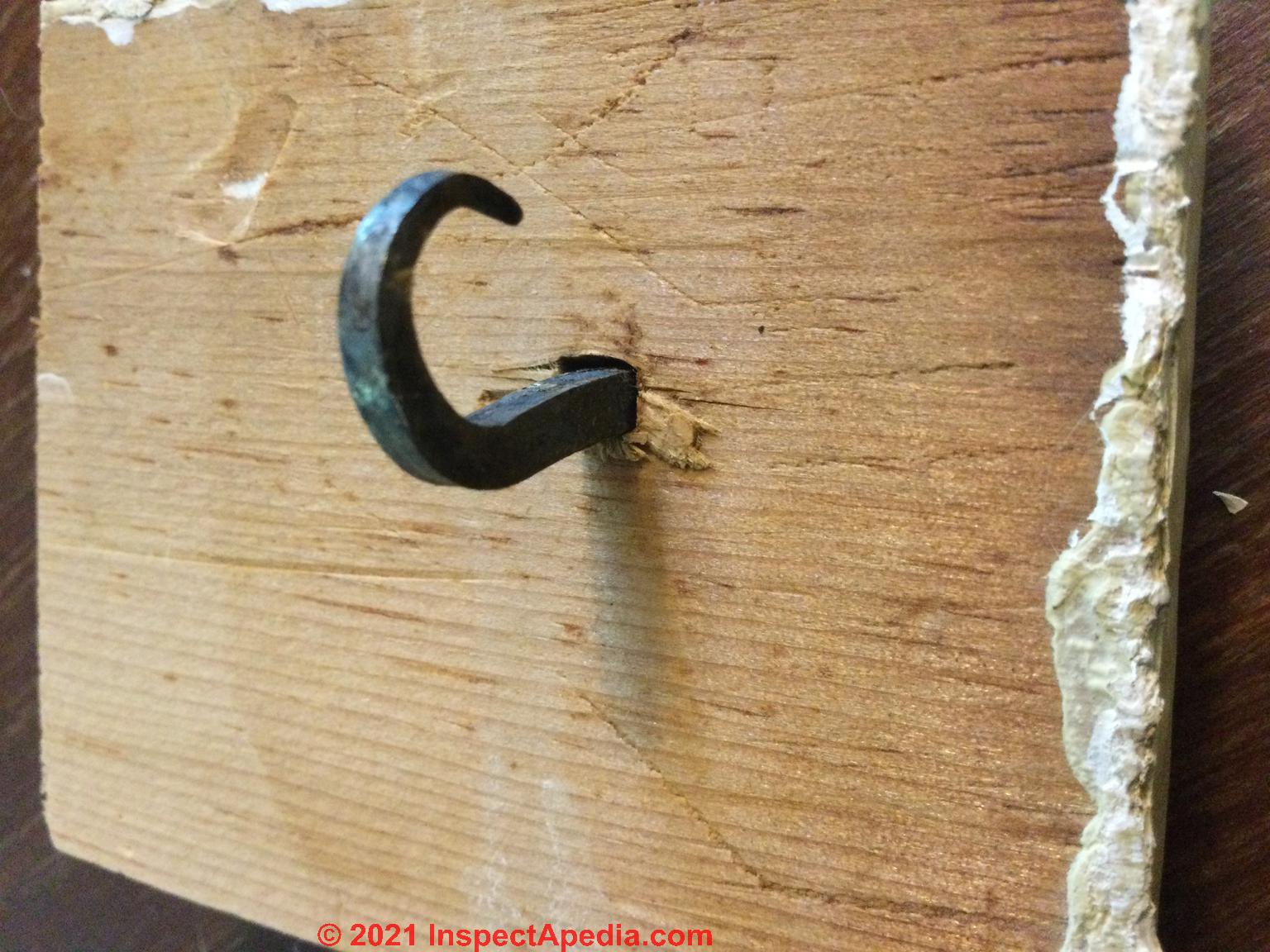
On 2021-05-21 - by (mod) -
@Susan,
Nice; certainly looks as if it is intended to be used as a hook.
On 2021-04-27 by Corey
I meant the bull skin trail, sorry for the typo. I can include dimensions and other photos if needed.
I found this old nail detecting an old farm field on the Ohio River. Historically I know that this spot is where the old buck skin trail met the river and was a common trading spot where the first colonists entered Ohio. Any thoughts on when it was made?
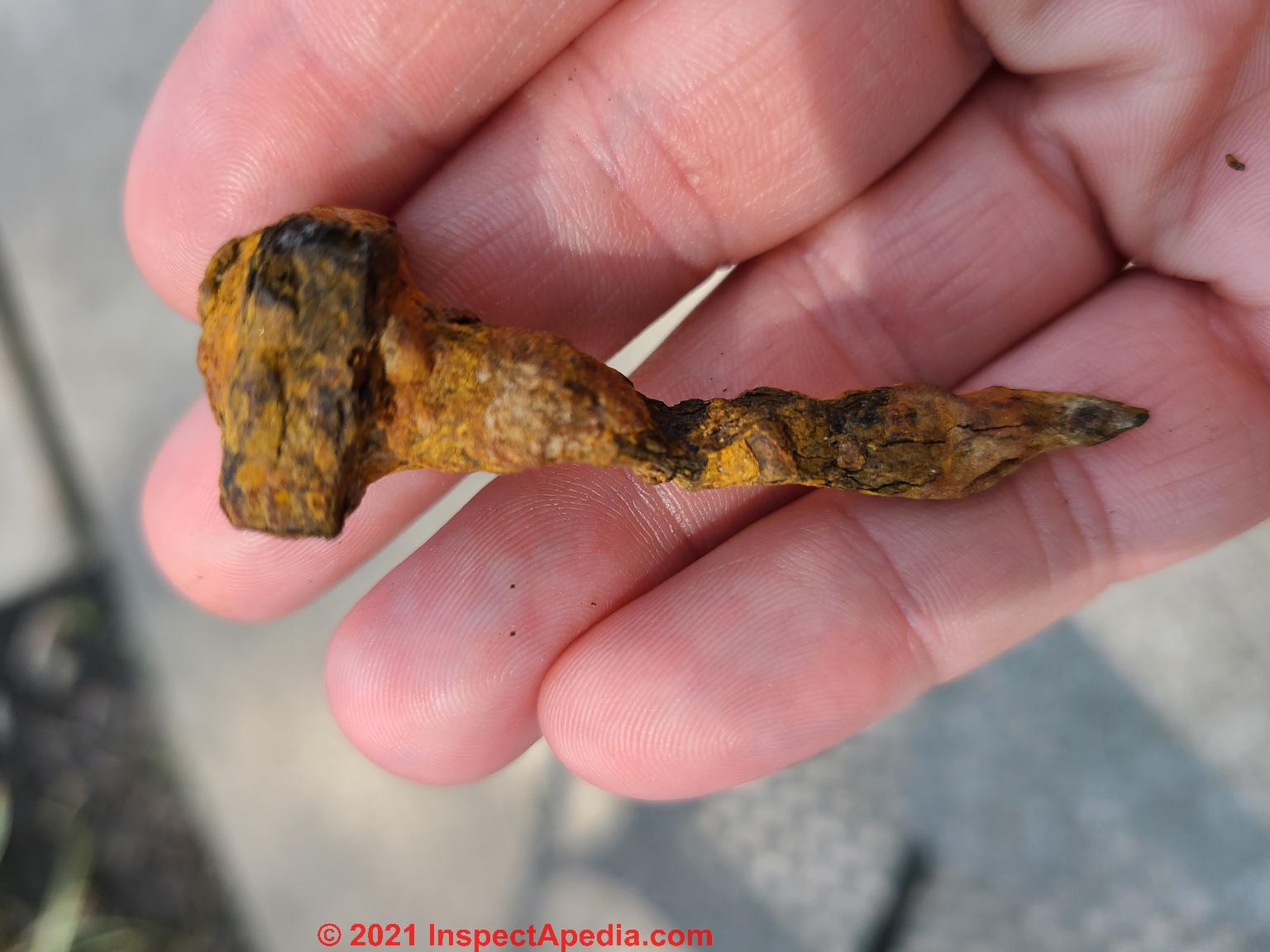
On 2021-04-27 by (mod) - Antique iron nail or bolt, Bull Skin Trail, Ohio river
@Corey, nice artifact, quite rusted away; square head; can't tell if the point is machine cut;
in sum for cases like this going through the key above is your best approach
In fact that square head may argue that this is a badly-rusted but modern square-headed bolt, not a nail.
On 2021-04-05 by Tabbatha Coulter
Any idea how old this 7" nail is?
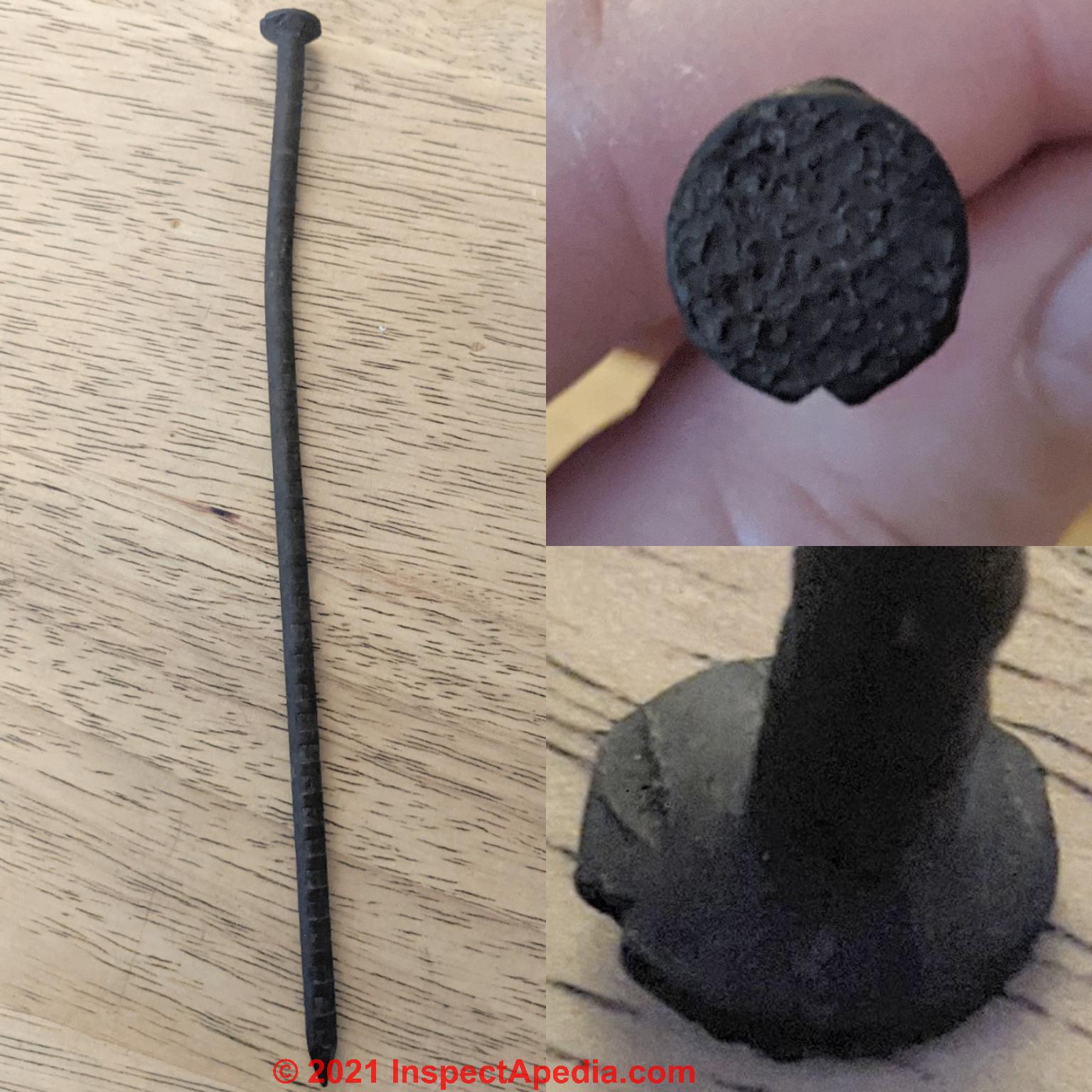
On 2021-04-05 - by (mod) -
@Tabbatha Coulter, that's a modern "wire" nail - as you can read in this article series, with a round shank and machine made components and diamond-shaped point. It could be an early one given the head details.
On 2021-04-05 by Meghan P
Hi,
I believe this is an 1800s machine cut nail that has been hand split. Wondering if this is in fact a nail and why it might have been split like this? It was found metal detecting right next to a an 1830-1860s cellar hole in the mountains of Vermont. Thank you so much! This is a fantastic resource.
On 2021-04-05 by (mod)
@Meghan P, that looks to me as if someone made a hat or coat hanger from old nails
On 2021-04-11 by Meghan
Thank you. That was my suspicion. It's cool to have found such a personal item from the original homestead.
On 2021-03-18 by Leslie Yount
Can you help me identify this 8-inch spike?
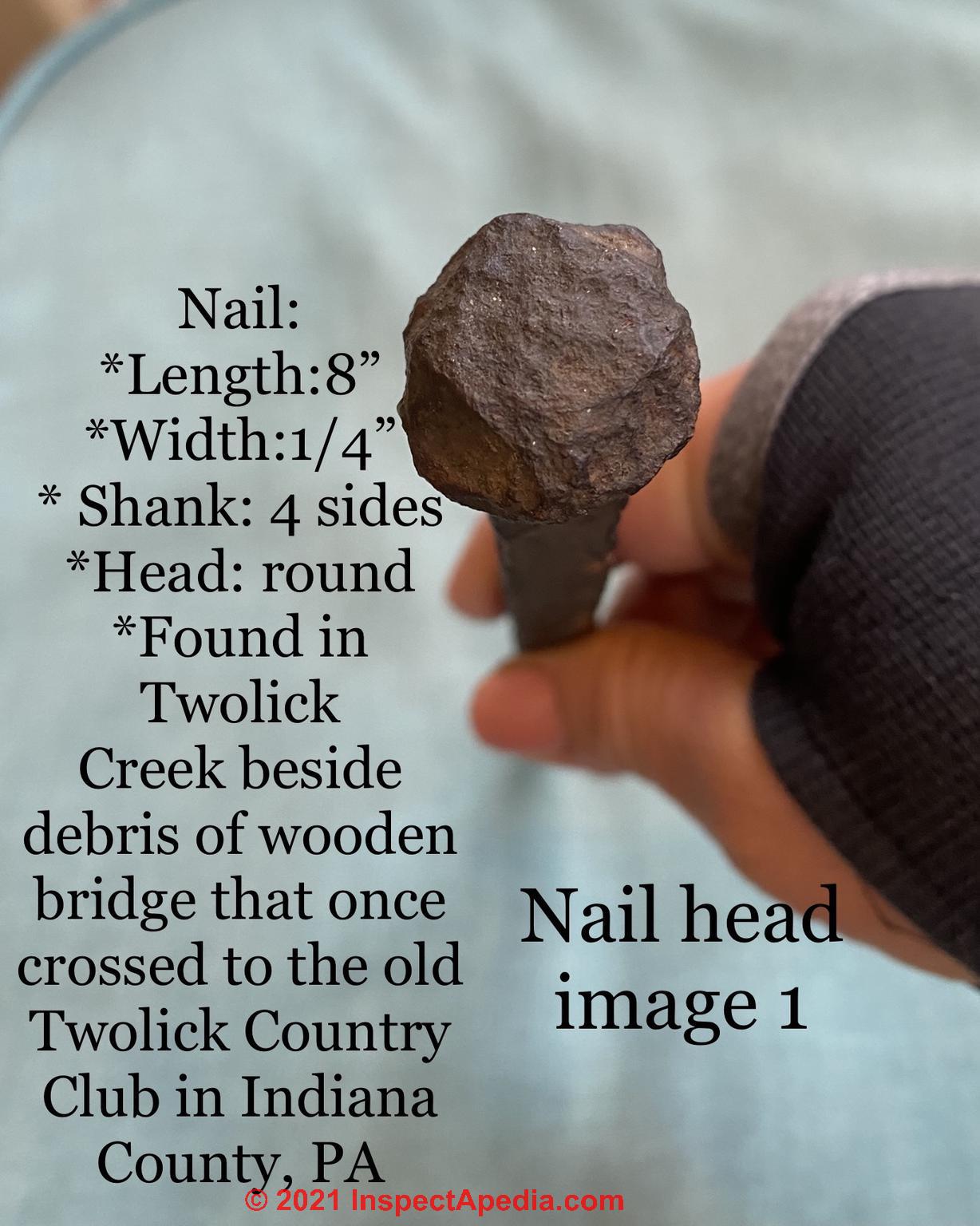
...
...
Any help you can give me is greatly appreciated. Thank you.
...
On 2021-03-18 by (mod) - dating details on an antique 8-inch iron spike found at Twolick Country Club, Indiana County PA
I agree that looks hand-wrought; take a look at the other nail-age guess suggestions in the home article for this topic.
The straight sides argue for a hand-wrought spike pre-dating cut-nails but not necessarily as the age of those two types of fasteners overlapped.
See if you can see any splits or signs of vertical grain in the nail shank and review that note in the article above.
Are these old nails in this old arrow-shaped stone? Kinagoe Bay, Ireland
[Click to enlarge any image]
Reader question:
I am wondering if you can help me.
I found this, washed ashore, on Kinagoe Bay on the northwest coast of Ireland
this week. We liked the arrow shape so took it home & since noticed what looks like nails? Apr 13, 2021, by reader
Would anyone have any ideas what this might have been?
Could it be off an old ship?
Or house?
Moderator reply: no - analysis shows that what you're holding is not an antique nail or spike
I'd like to see a sharper close up of what you think are nails, and I would like to know the thickness of the material and whether or not the suspected nails show up on the other side of the stone and also to see what that side looks like.
Another thing to look for if this is an artifact would be marks on the stone indicate that it was a worked material as opposed to a naturally occurring material and another would be to ask whether that particular kind of stone is something that occurs naturally in the area and whether or not you can find other pieces of the same material.
It seems possible that you are seeing an iron or other metal inclusion that occurs naturally in some stone but I really can't make out enough from the photos that you sent.
Reader follow-up:
This might help identify the stone.
I am attaching a few close up photos of what I think are nails? [Photos above and below]
Two can be seen through the other side but no actual point of nail. They don’t look natural.
Stone is smooth, almost worn & weathered.
I have no idea what type of stone it looks like.
I picked it up because it looked like an arrow & later we noticed the markings.It came in with the high tides we have had lately.
It was on Kinagoe Bay...off the Inishowen coast headland where the Trinidad Valencera sank. Photo below of Kinnagoe Bay, Ireland courtesy Google Maps
That’s easy to find online so one of your readers may know the stones/tiles etc of that area.
I would be more than happy for it to be posted.
I’m very curious & love the history of ‘everything & anything’!
It’s 5mm [thickness ? - Ed.]
Moderator reply: Potassic feldspars or similar inclusions in rock may look rectangular and iron-colored but are not nails
I'm not a rock authority but I suspect that what we're seeing are not nails but crystalline inclusions in the stone that occurred naturally.
Roberts (1975) has described the geology of the Kinnagoe Bay area of Ireland as does our Irish government document on North Donegal's geology cited below.
Your stone is probably blue-grey phyllite, naturally polished smooth by wind, water, sand.
My reasoning includes these observations:
1. Irregular not all nail-head shaped;
the reddish brown "things" are not all the same size and not all rectangular.
2. No tool marks:
there are no signs of having been hand worked such as hammer marks or tool marks
3. Fit in surrounding stone:
they fit perfectly and absolutely tightly into the stone - not something easily achieved if drilling or boring a hole in rock through which we plant to insert an iron fastener
4. Natural stone surfaces:
the stone itself doesn't look as if it's been worked-on - no tool marks, perfectly smooth surface5. Location in stone
not associated with fastening a stone tool to a handle or similar use.
Some of these iron-like inclusions in your stone are at very small and fragile stone locations like the stone tip - not a functional location at which someone would have tried to insert a nail [Photo below]But of course there are other observations (or experts) that (who) could change that opinion.
It would be informative to probe one of those inclusions to determine its hardness and it would be interesting to remove one to see if it's in fact iron (not that there couldn't be iron and magnetic inclusions).
Below are examples of inclusions found in concrete as well as naturally found in other stone; some of these can be quite rectangular. Notice however that their location in the concrete or stone is not regular.
Photo above of iron-like inclusions in concrete is from the article cited immediately below.
- FOUNDATION DAMAGE by MATERIAL or INCLUSIONS - InspectApedia.com article
- Bryant, Lee Davis. GEOTECHNICAL PROBLEMS WITH PYRITIC ROCK AND SOILl [PDF] (2003) Thesis for MS in Civil Engineering, retrieved 2017/08/03, original source: https://theses.lib.vt.edu/theses/available/etd-05212003-173107/unrestricted/ThesisAll.pdf
- Grimmer, Anne E., Jo Ellen Hensley, Liz Petrella, Audrey T. Tepper, ILLUSTRATED GUIDELINES on SUSTAINABILITY for REHABIITATING HISTORIC BUILDINGS [PDF] (2011) U.S. Department of the Interior, National Park Service, Standards for Rehabilitation, retrieved 2022/09/2, original source: https://portal.ct.gov/-/media/DECD/Historic-Preservation/03_Technical_Assistance_Research/guidelines-sustainability.pdf
- NORTH DONEGAL - COUNTY GEOLOGICAL SITE REPORT [PDF] Government of Ireland, Department of the Environment, Climate and Communications, 29-31 Adelaide Road, Dublin 2, D02 X285 Website:www.gov.ie/decc
Email:customer.service@decc.gov.ie Phone number:01 678 2444
retrieved 2021/04/17 original source: https://secure.dccae.gov.ie/GSI_DOWNLOAD/Geoheritage/Reports/ND006_Kinnagoe_Bay.pdf
Excerpts:
Kinnagoe Bay comprises a scenic and sheltered strand at the foot of a steep plunging cliff and bluff lined coast at the head of a wide bay. The cliffs and bluffs are thickly vegetated with scrub and trees, with vegetated dunes areas at the back of the beach.
Geological System/Age and Primary Rock Type
The beach and back beach dune system have developed in the last 12,000 years since the end of the last Ice Age, and is Holocene in age. Coastal bedrock exposures of Dalradian Supergroup grit and phyllite (similar to slate) crop out in the intertidal zone at discontinuous sections along the beach, with many outcrops polished smooth by wind-blown sand.
The beach also exhibits fine examples of sand-blasted rock, as seen on the blue-grey phyllite outcrops on the beach (663010E 945900N).
At the western end of Kinnagoe Bay, in the vicinity of the car park, coarse graded grits and phyllitic slates are extensively reddened. This colouration feature is uncommon in the Dalradian rocks of Inishowen and Donegal.
In 1980, a diving expedition to the wreck of the La Trinidad Valencera retrieved a beach pebble (red/orange calcareous mudstone) of the foreshore below the coastguard station, containing a small (31mm) ammonite of the Lower Liassic genus Echioceras. The pebble is understood to be glacial debris, and not local.
Early OSI 25” sheets record a disused lime kiln near the gully at the west end of the beach cliffs.- Potassic Feldspars*: (microcline, orthoclase) Potassic feldspars are pink or tan, sometimes white. They show flat, shiny faces in igneous rocks. The crystal grains are usually blocky and nearly rectangular. http://www.minsocam.org/msa/collectors_corner/id/rock_key.htm
- Roberts, J. C. "Reddened Rocks in the Upper Dalradian Succession of North-Eastern Inishowen." The Irish Naturalists' Journal (1975): 136-140.
Abstract:
Reddened rocks are described from strata of Upper Dalradian age in north-eastern Inishowen.
The field occurrence of the reddened strata suggests a diversity of origin whilst their association, at least locally, with thick feldspar conglomerates is considered to be significant, and must indicate either temporary shallowing or strongly oxidizing conditions in the depositional area.
...
Continue reading at NAILS, AGE & HISTORY - topic home, or select a topic from the closely-related articles below, or see the complete ARTICLE INDEX.
Or see NAILS & HARDWARE, AGE FAQs - more Q&A on determining the age of nails.
Or see these
Recommended Articles
- AGE of a BUILDING, HOW to DETERMINE - home
- DOOR HARDWARE AGE
- NAILS, AGE & HISTORY - home
- HORSESHOE & HORSESHOE NAIL AGE
- NAIL & HARDWARE, AGE RESEARCH
- NAIL & HARDWARE CLEAN-UP
- NAIL AGE DETERMINATION KEY - use this key to guess at the age of your nail or spike
- NAIL ID & AGE: CUT NAILS
- NAIL ID & AGE: HAND FORGED NAILS
- NAILS in BARTER & TRADE
- NAIL SPLITS & CRACKS vs AGE
- NAIL TYPE, ANTIQUE, IDENTIFICATION KEY
- RAILROAD SPIKES
- RAILROAD SPIKE AGE - CONTEXTUAL CLUES
- SAW & AXE CUTS, TOOL MARKS, AGE
- WINDOW HARDWARE AGE
Suggested citation for this web page
NAILS & HARDWARE, AGE FAQs-4 at InspectApedia.com - online encyclopedia of building & environmental inspection, testing, diagnosis, repair, & problem prevention advice.
Or see this
INDEX to RELATED ARTICLES: ARTICLE INDEX to BUILDING AGE
Or use the SEARCH BOX found below to Ask a Question or Search InspectApedia
Ask a Question or Search InspectApedia
Try the search box just below, or if you prefer, post a question or comment in the Comments box below and we will respond promptly.
Search the InspectApedia website
Note: appearance of your Comment below may be delayed: if your comment contains an image, photograph, web link, or text that looks to the software as if it might be a web link, your posting will appear after it has been approved by a moderator. Apologies for the delay.
Only one image can be added per comment but you can post as many comments, and therefore images, as you like.
You will not receive a notification when a response to your question has been posted.
Please bookmark this page to make it easy for you to check back for our response.
IF above you see "Comment Form is loading comments..." then COMMENT BOX - countable.ca / bawkbox.com IS NOT WORKING.
In any case you are welcome to send an email directly to us at InspectApedia.com at editor@inspectApedia.com
We'll reply to you directly. Please help us help you by noting, in your email, the URL of the InspectApedia page where you wanted to comment.
Citations & References
In addition to any citations in the article above, a full list is available on request.
- In addition to citations & references found in this article, see the research citations given at the end of the related articles found at our suggested
CONTINUE READING or RECOMMENDED ARTICLES.
- Carson, Dunlop & Associates Ltd., 120 Carlton Street Suite 407, Toronto ON M5A 4K2. Tel: (416) 964-9415 1-800-268-7070 Email: info@carsondunlop.com. Alan Carson is a past president of ASHI, the American Society of Home Inspectors.
Thanks to Alan Carson and Bob Dunlop, for permission for InspectAPedia to use text excerpts from The HOME REFERENCE BOOK - the Encyclopedia of Homes and to use illustrations from The ILLUSTRATED HOME .
Carson Dunlop Associates provides extensive home inspection education and report writing material. In gratitude we provide links to tsome Carson Dunlop Associates products and services.



